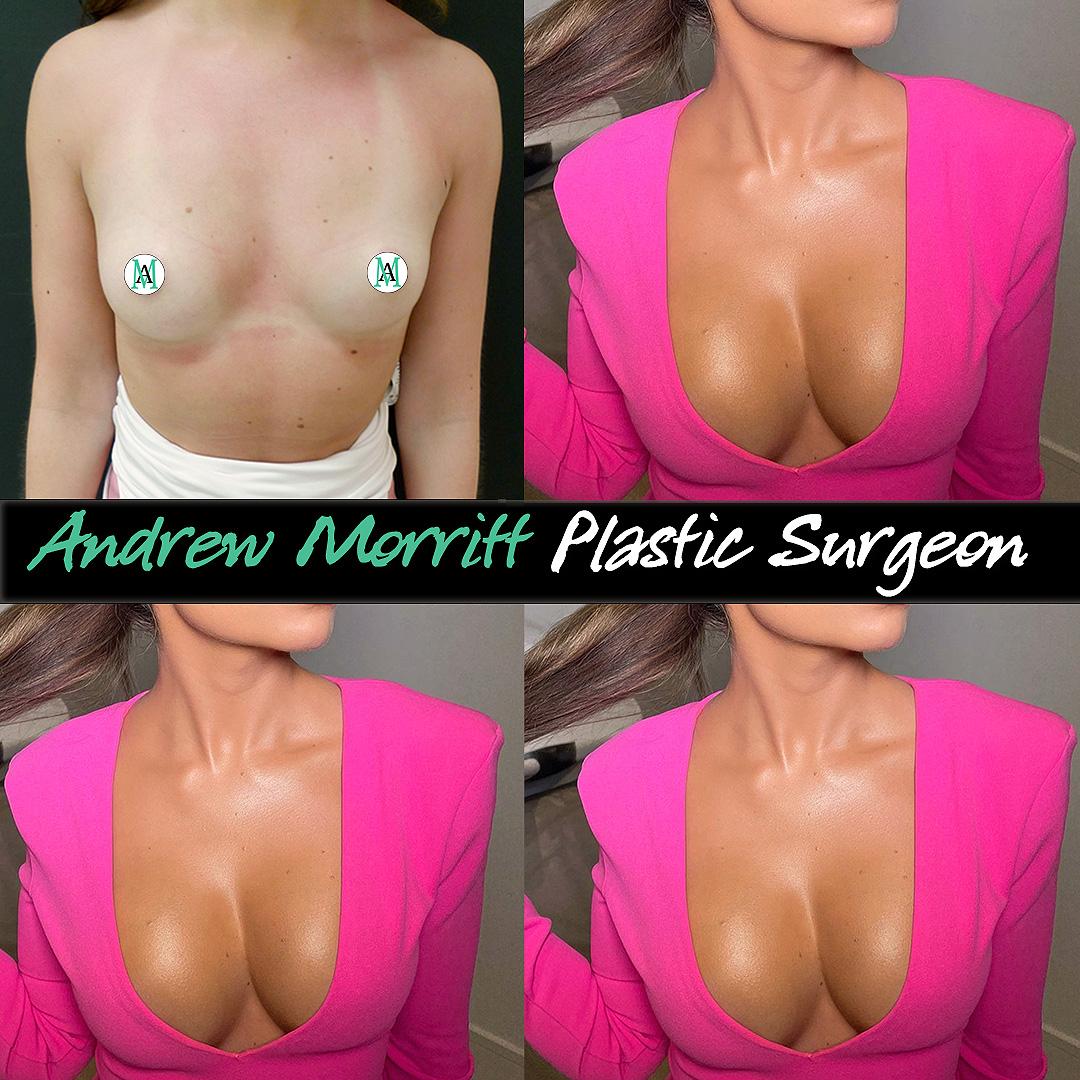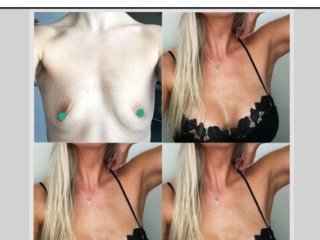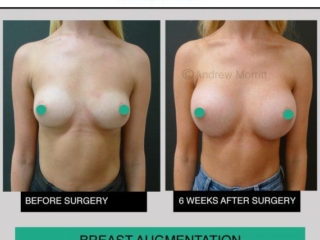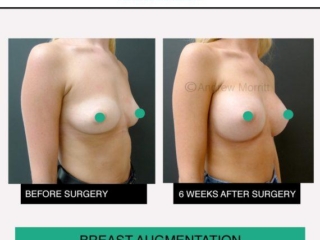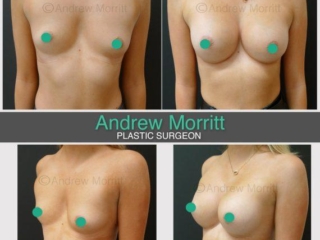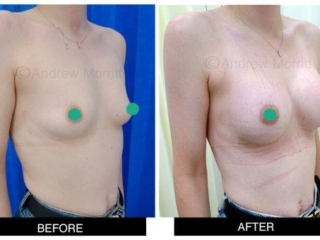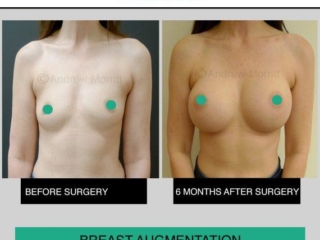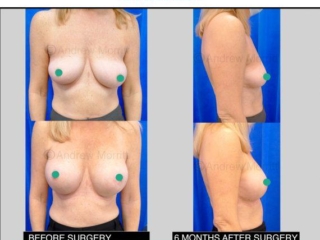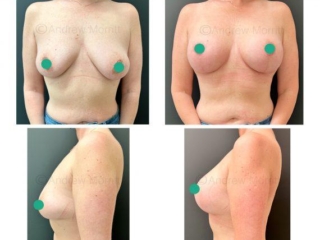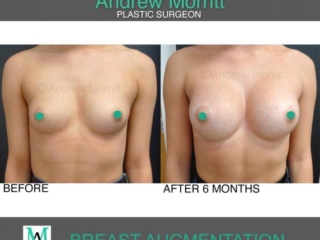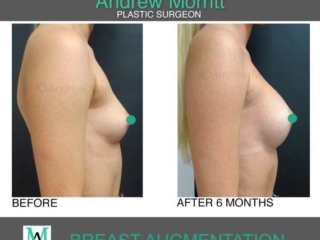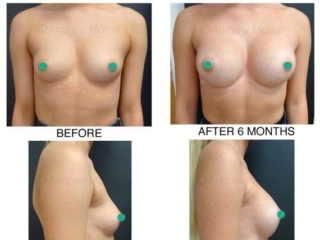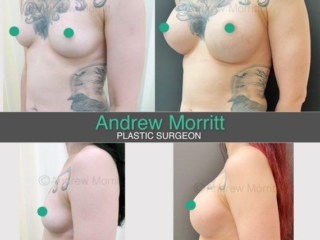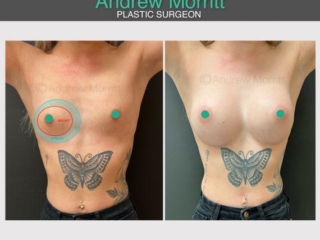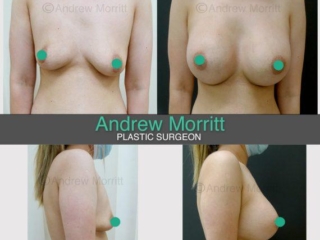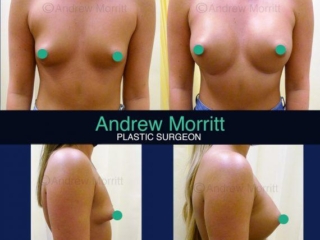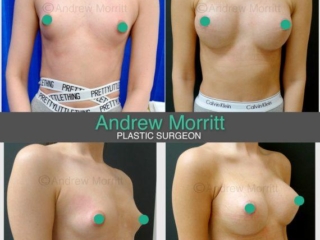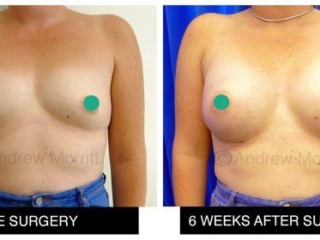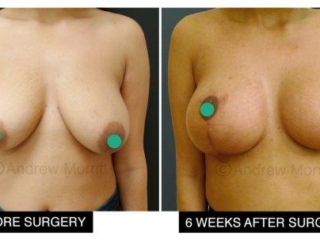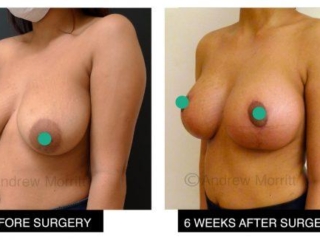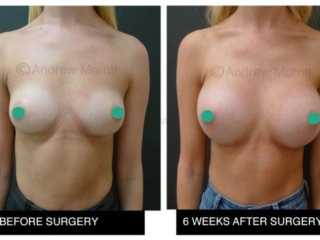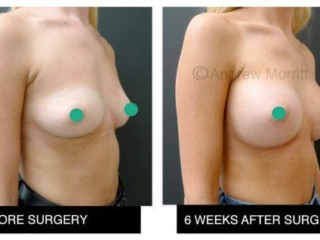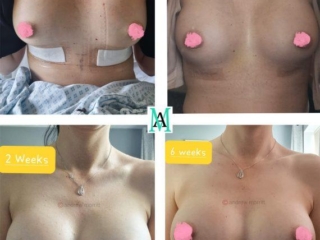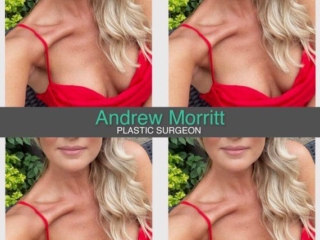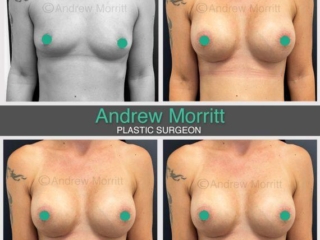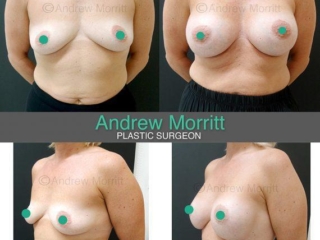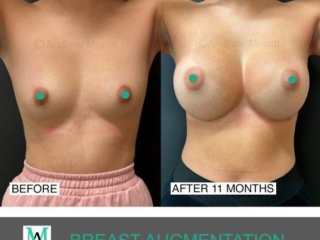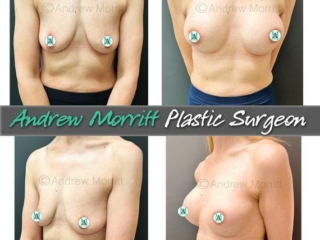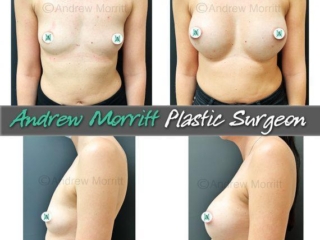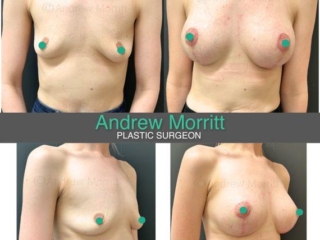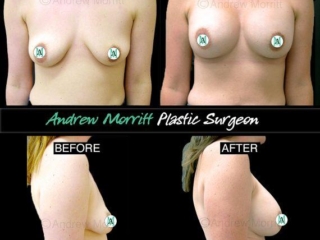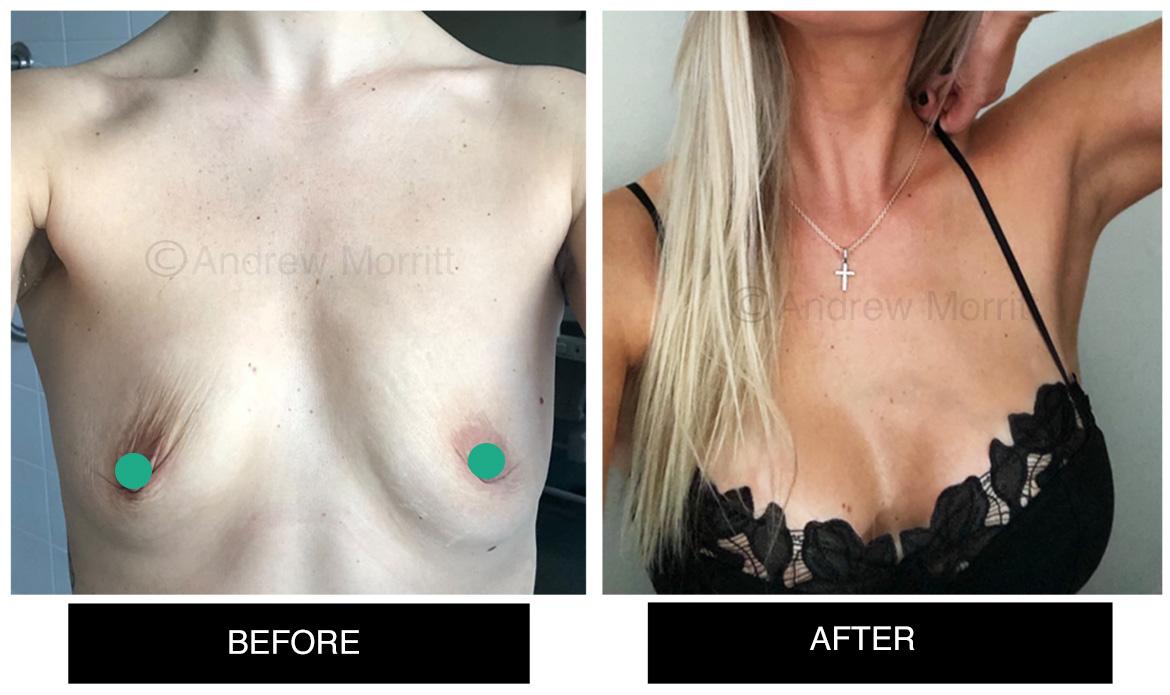Breast augmentation (breast enlargement)
Mr Morritt is a specialist in breast augmentation surgery (breast enlargement, breast implants, or a ‘boob job’). Breast augmentation involves inserting breast implants to increase breast size and improve shape. Fat injections (lipofilling) can be used to achieve modest breast size increases but the results are not as predictable or dramatic as with breast implants. In some patients a combination of breast implants and lipofilling is used to optimise the outcome from breast enlargement (hybrid breast augmentation). Mr Morritt regularly undertakes breast enlargement surgery at the Spire Claremont Hospital and Thornbury Hospitals in Sheffield. Mr Morritt aims to deliver natural looking results from surgery.
To learn about the other procedures that Mr Morritt offers – please click here
5 * Review from one of Mr Morritt’s Sheffield breast augmentation patient’s
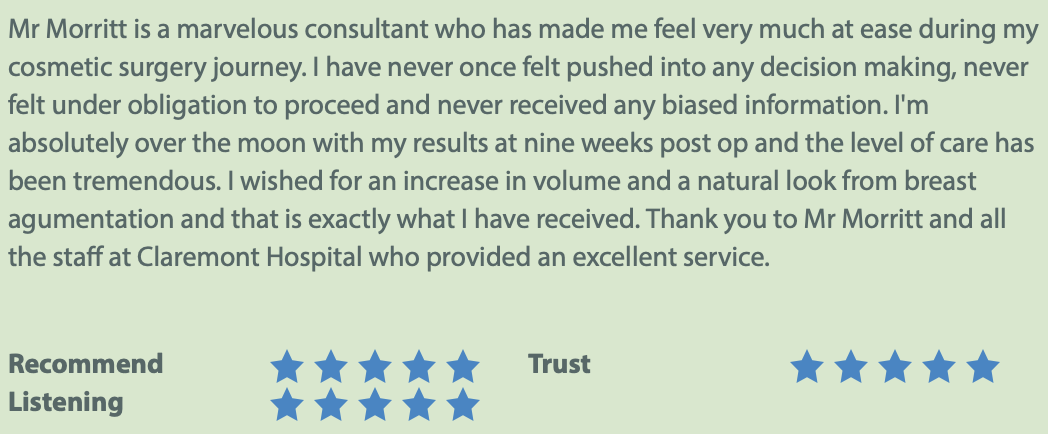
Breast enlargement – typical patients
Breast enlargement is most frequently performed to:
- Increase the size of small breasts
- Restore lost breast volume following pregnancy, weight loss or ageing
- Improve breast symmetry (in cases of breast asymmetry)
- Lift the breasts in women with minor drooping who do not want the scars associated with a breast uplift (mastopexy)
- Improve the balance of body proportions and in turn improve the fit of clothing
- Improve self-confidence
Breast augmentation – Before and after photos
Please note that while these photos show outcomes from Mr Morritt’s breast augmentation patients, the outcome of surgery varies for individual patients due to skin characteristics, build etc and Mr Morritt can not therefore guarantee an exact outcome from surgery.
Summary of cases – please see below for details of individual cases
Case 1. Photos showing appearances before and after breast augmentation surgery with round 325cc moderate plus profile breast implants placed subglandular (in front of muscle). Patient in her 20’s, no children. Thanks to my patient for giving permission to show these images.
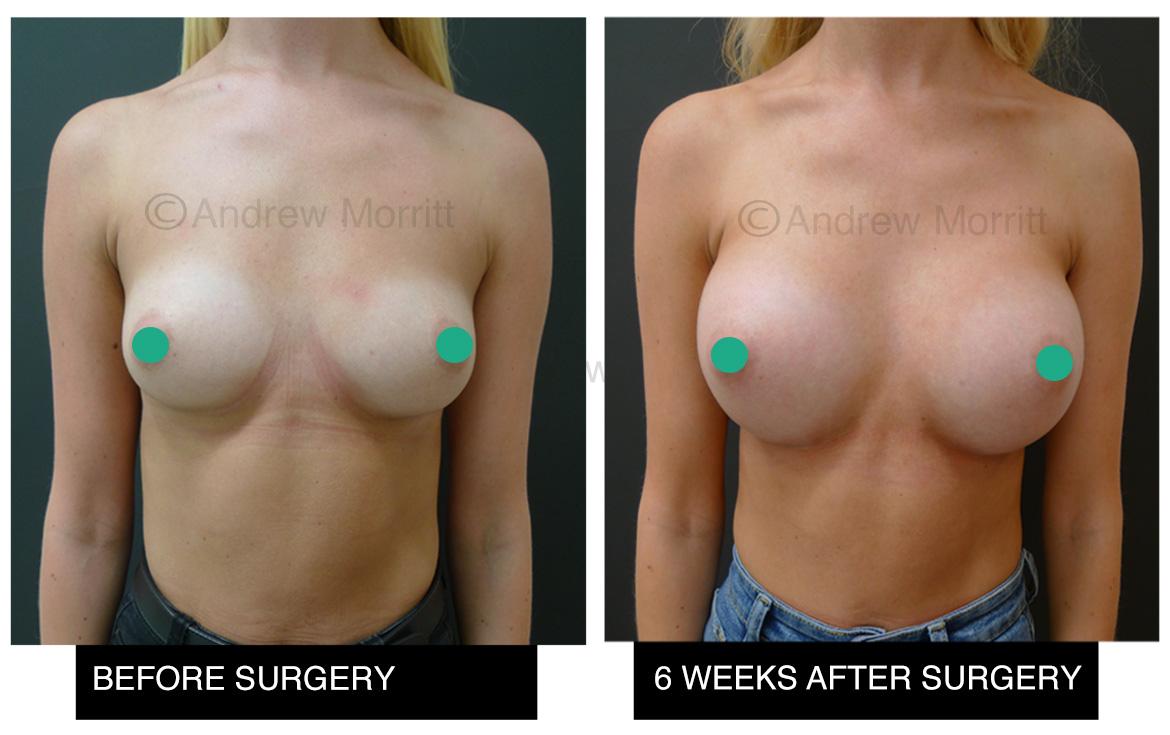

Case 2: Photos showing appearances before and after breast enlargement with Round 425cc high profile silicone breast implants Dual Plane (partially under muscle). Patient with one children requesting a natural looking result. Bra size increase from 38B before surgery to 38D after surgery. Thanks to my patient for giving permission to show these images.
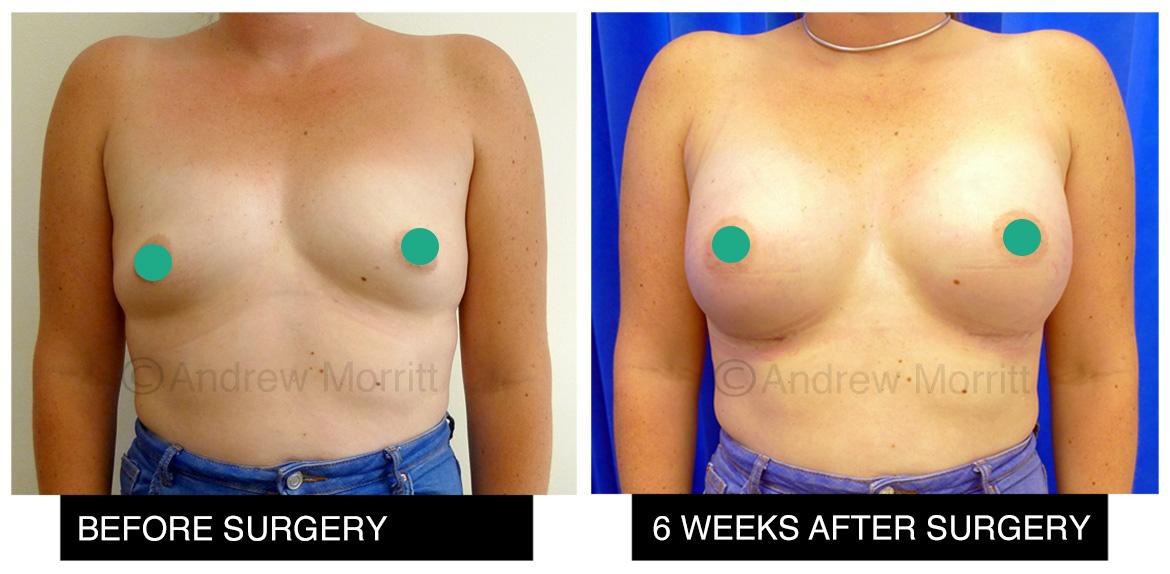
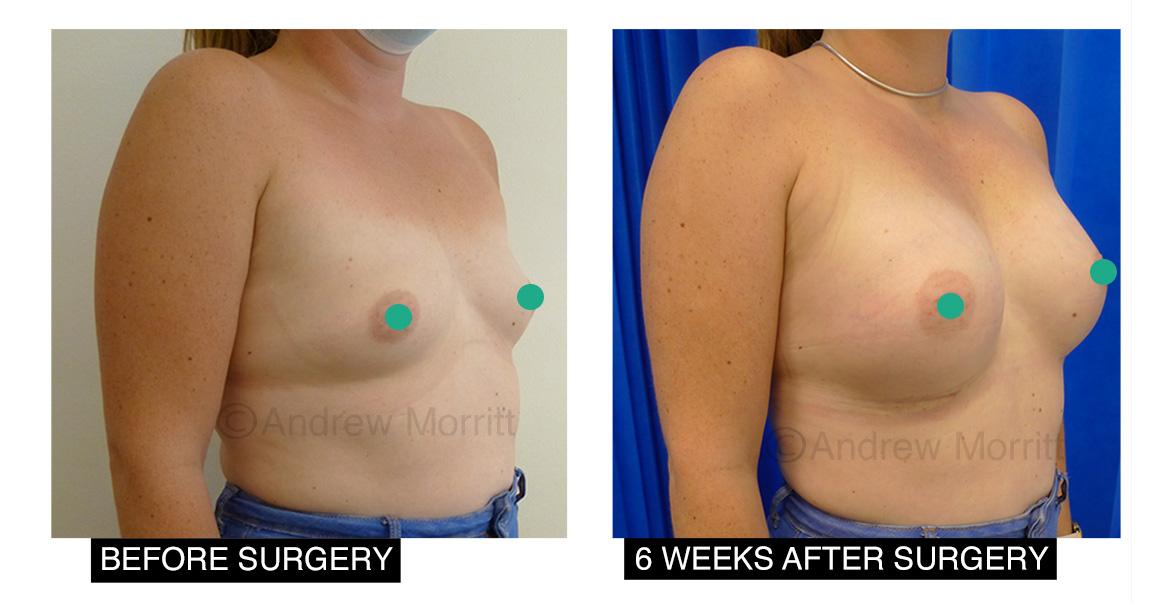
Case 4 – Breast augmentation patient selfies: my lovely patient sent these before and after photos to show the differences that breast augmentation surgery made to her appearance. Having completed her family after breast feeding 2 children, my patient wanted to restore the fullness to her breasts and improve the proportions of her body. Silicone breast implants increased her breast volume and took up the loose skin giving her a more youthful contour. Thanks to my patient for giving permission to show these images of her boob job.
Case 5. Photos showing appearances before and after breast augmentation. My patient requested breast enlargement with a natural look and also wanted correction of her breast asymmetry. During one operation the left breast was firstly reduced in volume and left nipple lifted so that the left and right breasts matched more closely before round silicone breast implants were inserted in front of the muscle to increase breast size. Thanks to my patient for giving permission to show these images.
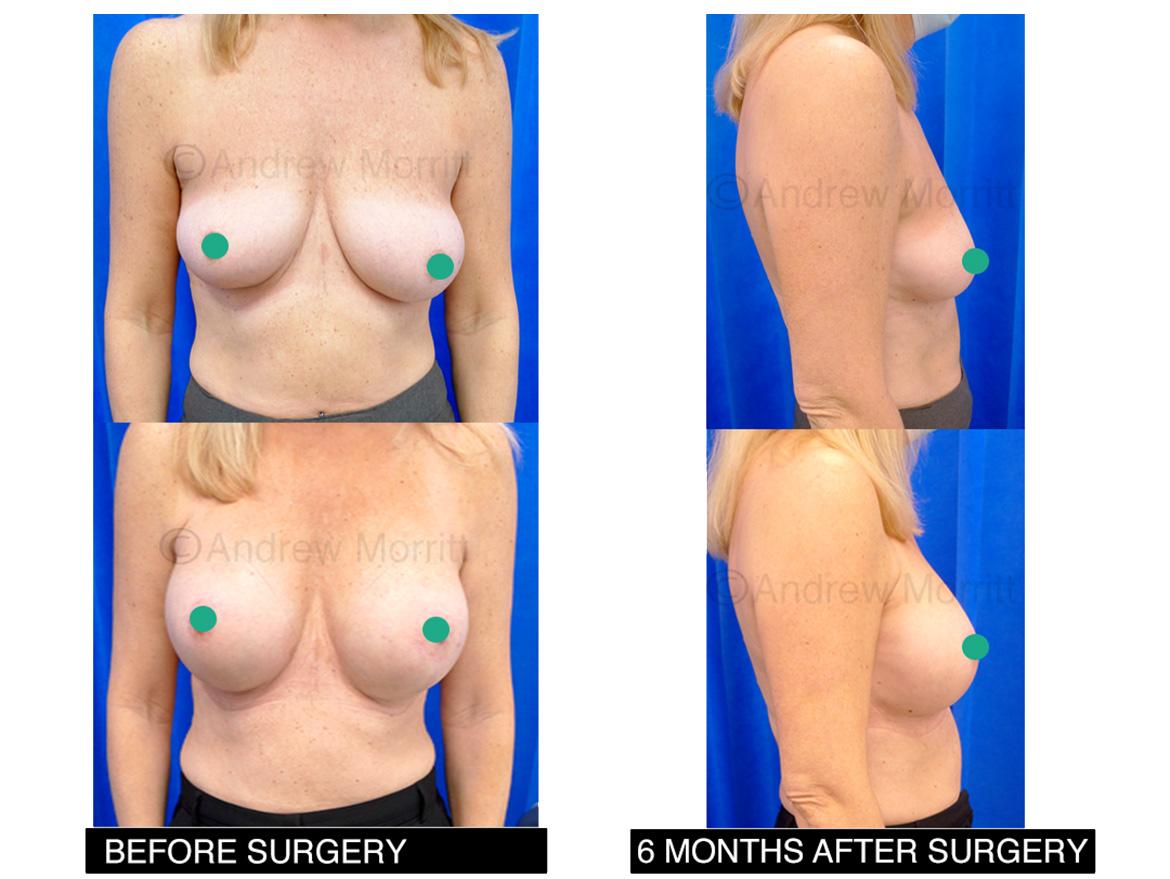
Case 6. Photos showing appearances before and after breast augmentation. This slim lady with small breasts requested a natural looking boob job. 325cc round high profile breast implants were placed using the Dual plane type 1 technique (under the muscle). Appearances shown 6 weeks after surgery. Thanks to my patient for giving permission to show these images.
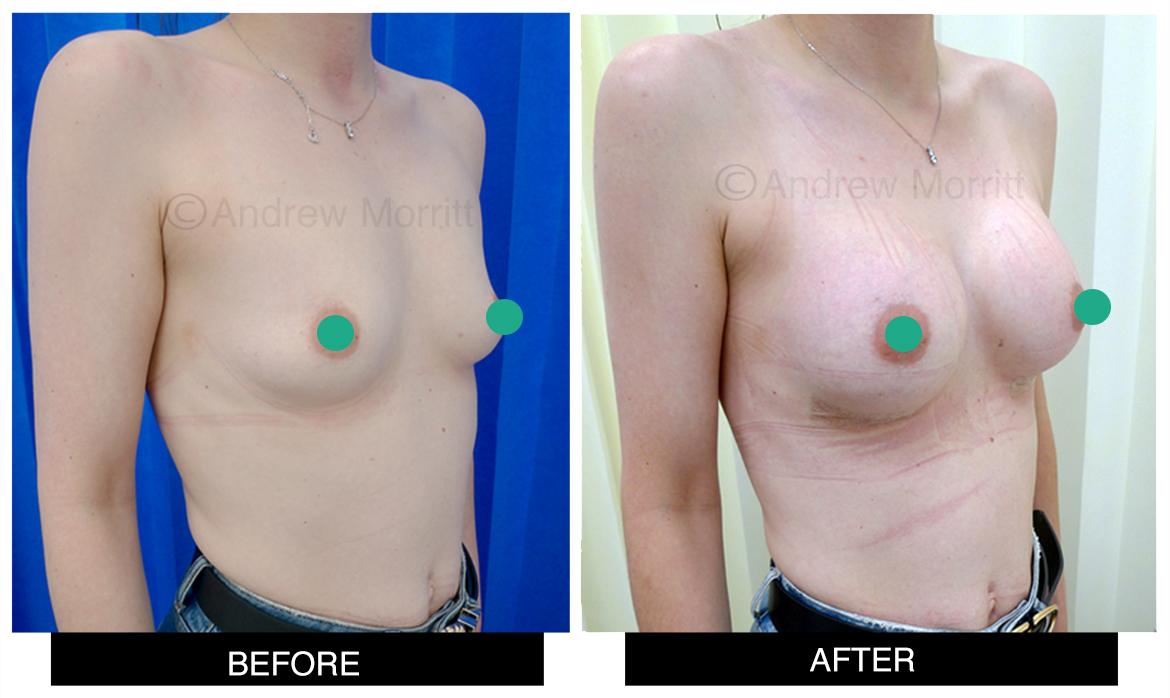
Case 7. Photos showing appearances before and after breast enlargement. Natural looking results for this mum in her 30’s who had breast augmentation with round 475cc breast implants placed in front of the chest muscle but under the ‘fascial’ layer (subfascial breast augmentation). Thanks to my patient for giving permission to show these images of her boob job.
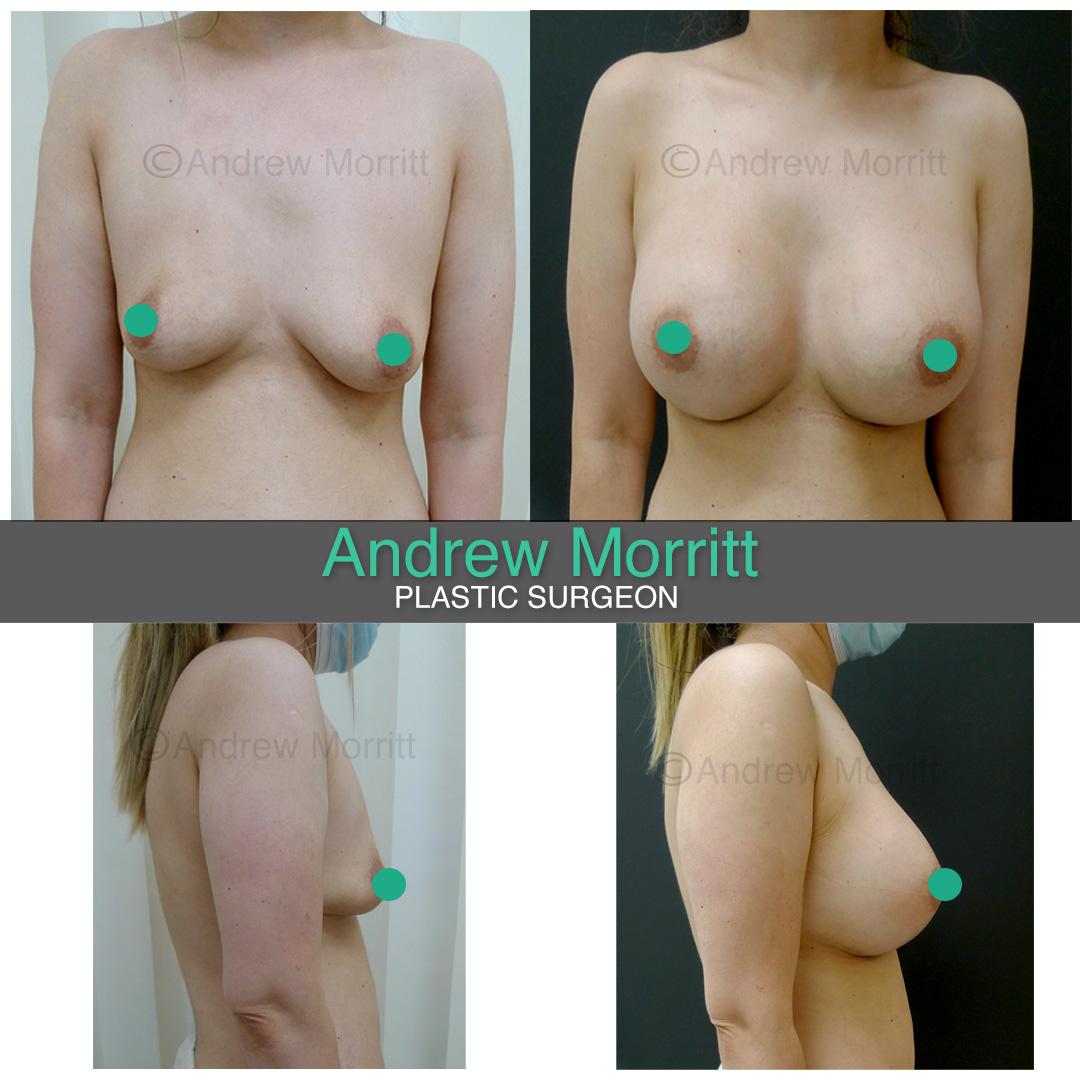
Case 8. Before and after photos showing the appearance of a patient in her 20’s with tuberous breasts who had breast augmentation surgery. Note how before boob job surgery there is only minimal breast tissue in the lower part of the breast and the skin is very tight which is a feature of tuberous breasts (sometimes called tubular breasts). A round high profile breast implant has been placed under the chest muscle (dual plane type 1). In patients who have tight skin (e.g. those who have not had children) it takes time for the breast skin to loosen after breast augmentation and for the breasts to get to develop their final shape. Appearances shown after 6 months. Thanks to my patient for giving permission to show these images.
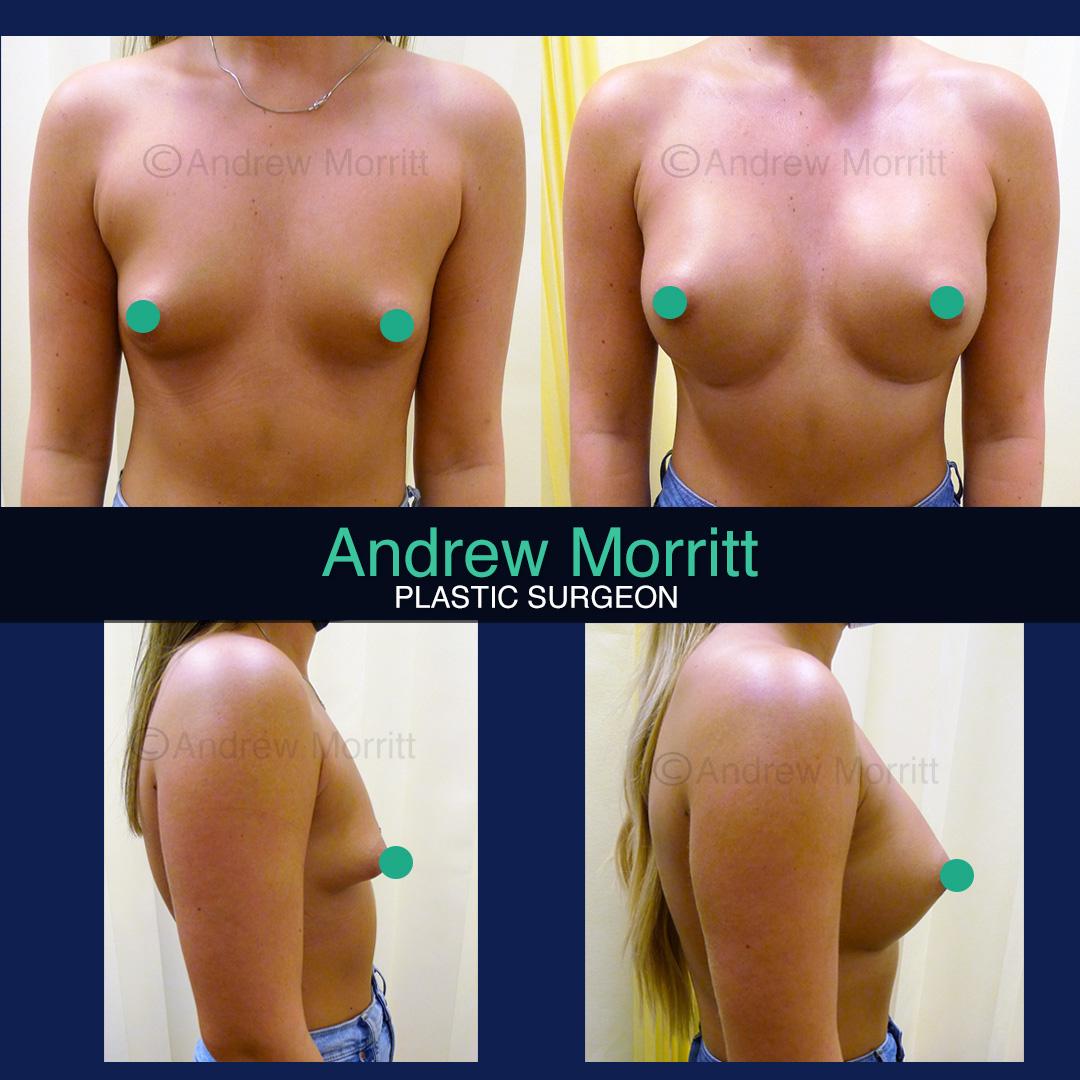
Case 9. Before and after photos of a patient who had breast augmentation surgery. This lady was very conscious of her pectus excavatum which means a sunken or indented breast bone and also unhappy with her small breasts. She was keen to increase the size of her breasts whilst keeping the appearances natural. Teardrop breast implants (also known as ‘anatomical’ breast implants) were placed under the chest muscle (dual plane type 1) and the gap between the breasts was narrowed to disguise the pectus deformity. Thanks to my patient for giving permission to show these images.
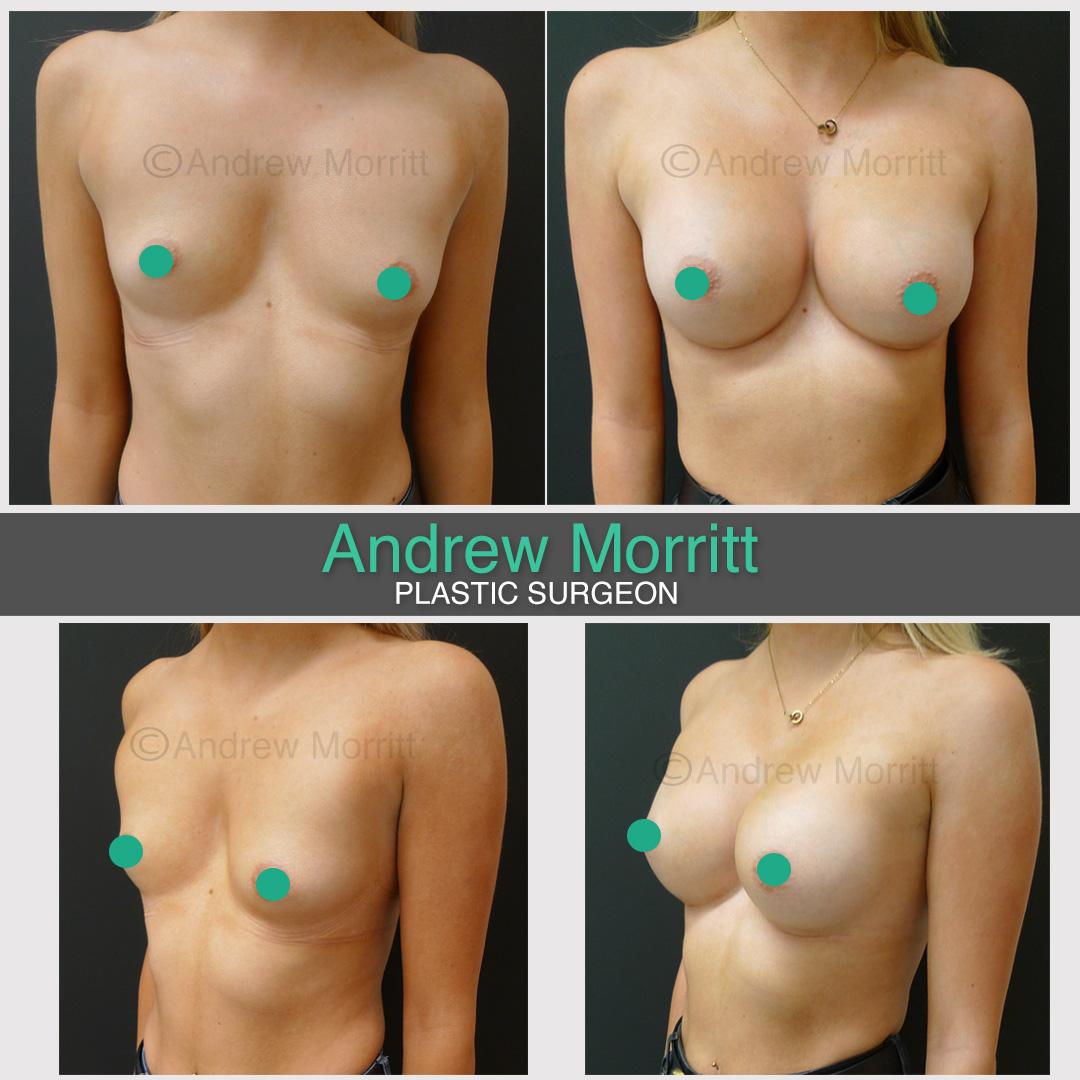
Case 10. Before and after photos showing appearances of a lady in her 20’s with mild tuberous breasts who had breast augmentation and areolar tightening/reduction. Patient’s with tuberous breasts have varying degrees of differences including tightness in the lower part of the breast. In this case the patient was conscious about her puffy nipples. Breast augmentation alone would have made the puffiness more prominent so this lady requested tightening of the areolae which was done using a circumareolar mastopexy technique (scars around the areola). Nipple sensation was not affected. Thanks to my patient for giving permission to show these images.
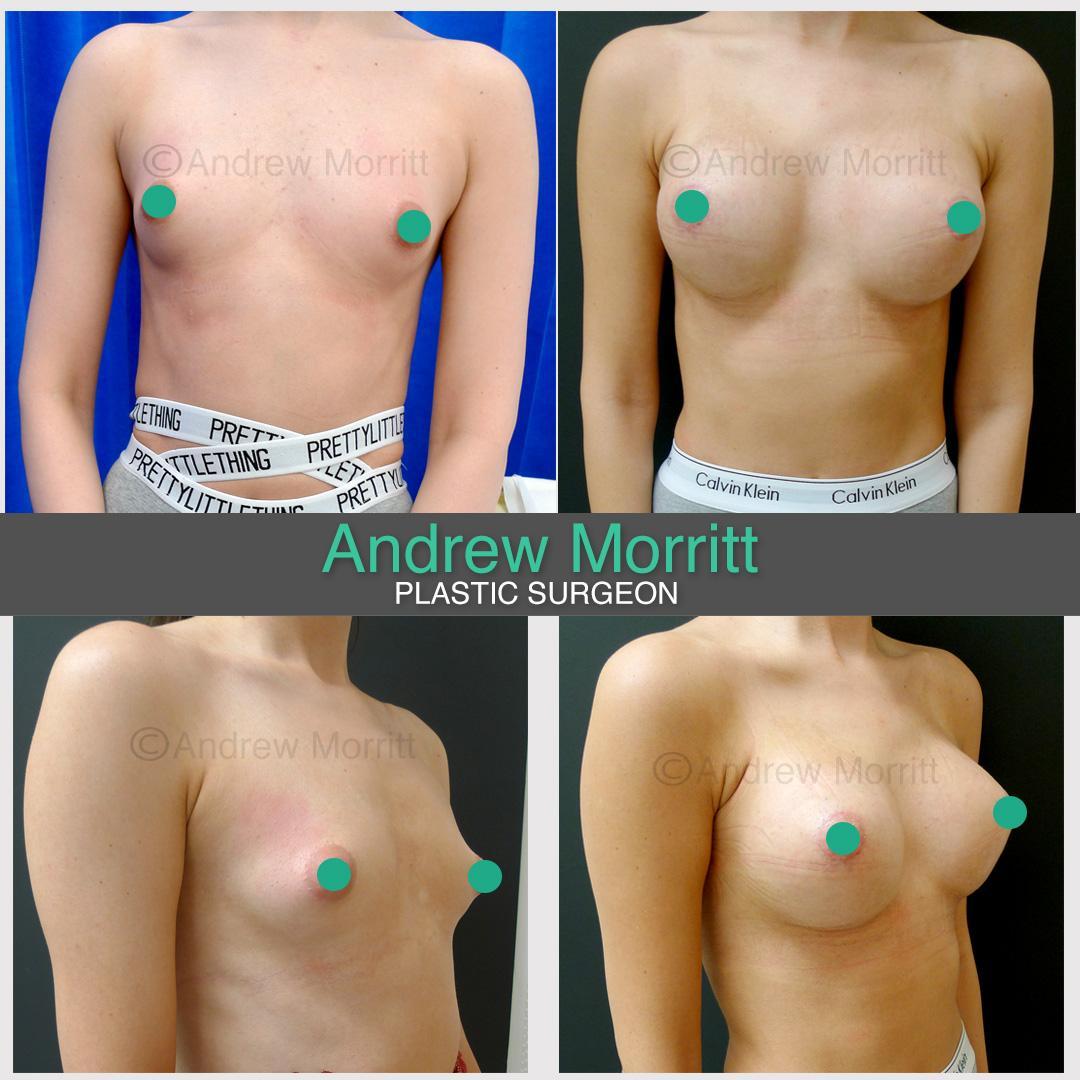
Case 11. Before and after photos showing appearances of a lady in her 30’s (no children) who had breast augmentation surgery 6 months earlier with round breast implants (Moderate plus profile, dual plane type 1 (partially under the chest muscle)). Boob job surgery increased her breast size from 32B to 34DD (30G in one manufacturer!). Thanks to my patient for giving permission to show these images.
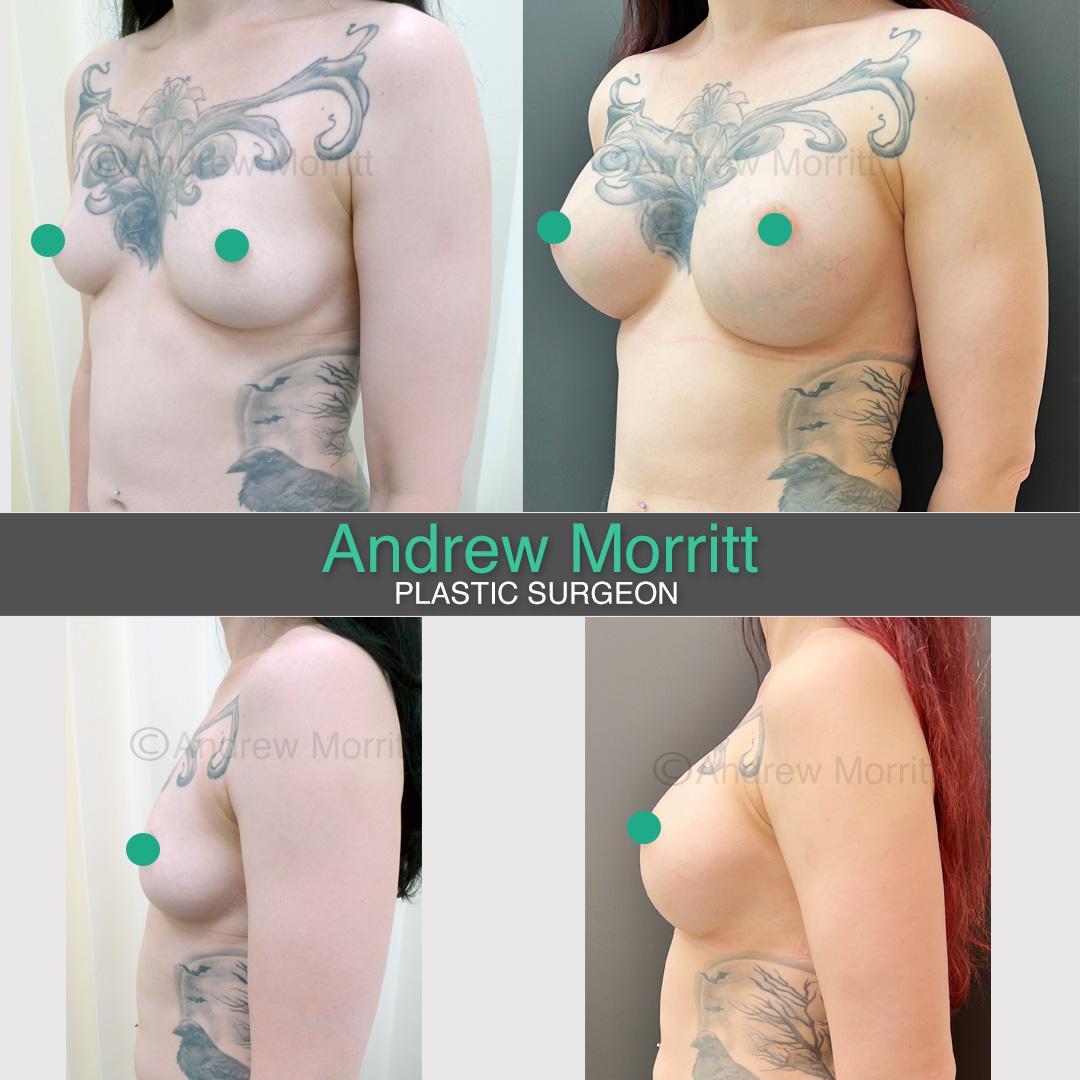
Case 12. Photos showing appearances before and 6 months after breast augmentation surgery for this lady in her 20’s. Round 300cc breast implants. Thanks to my patient for giving permission to show these images.
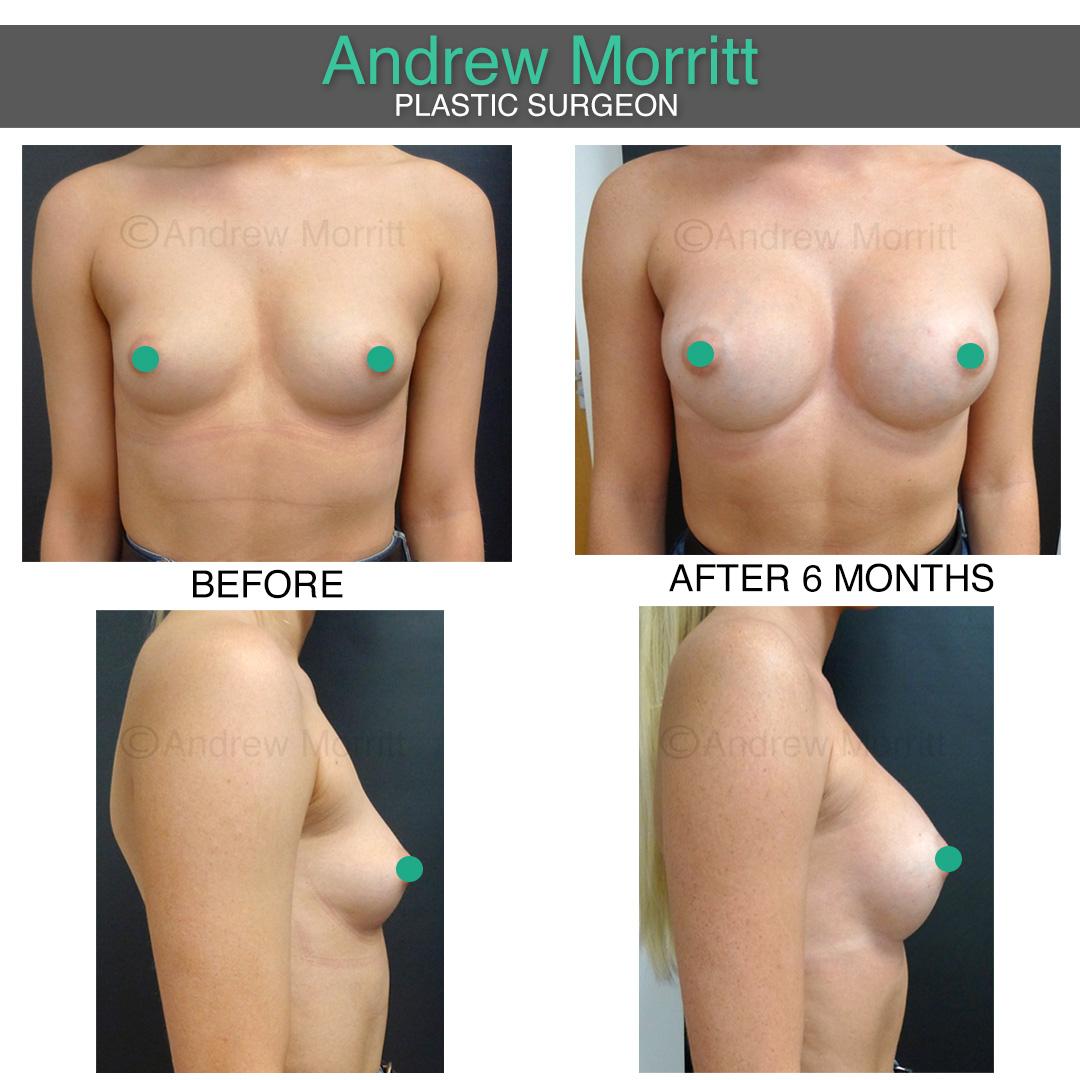
Case 13. Photos showing appearances before and after breast augmentation. This patient’s bra size increased from a 34A to 34D with round ‘moderate plus’ breast implants inserted in front of the chest muscle. Thanks to my patient for giving permission to show theses images.
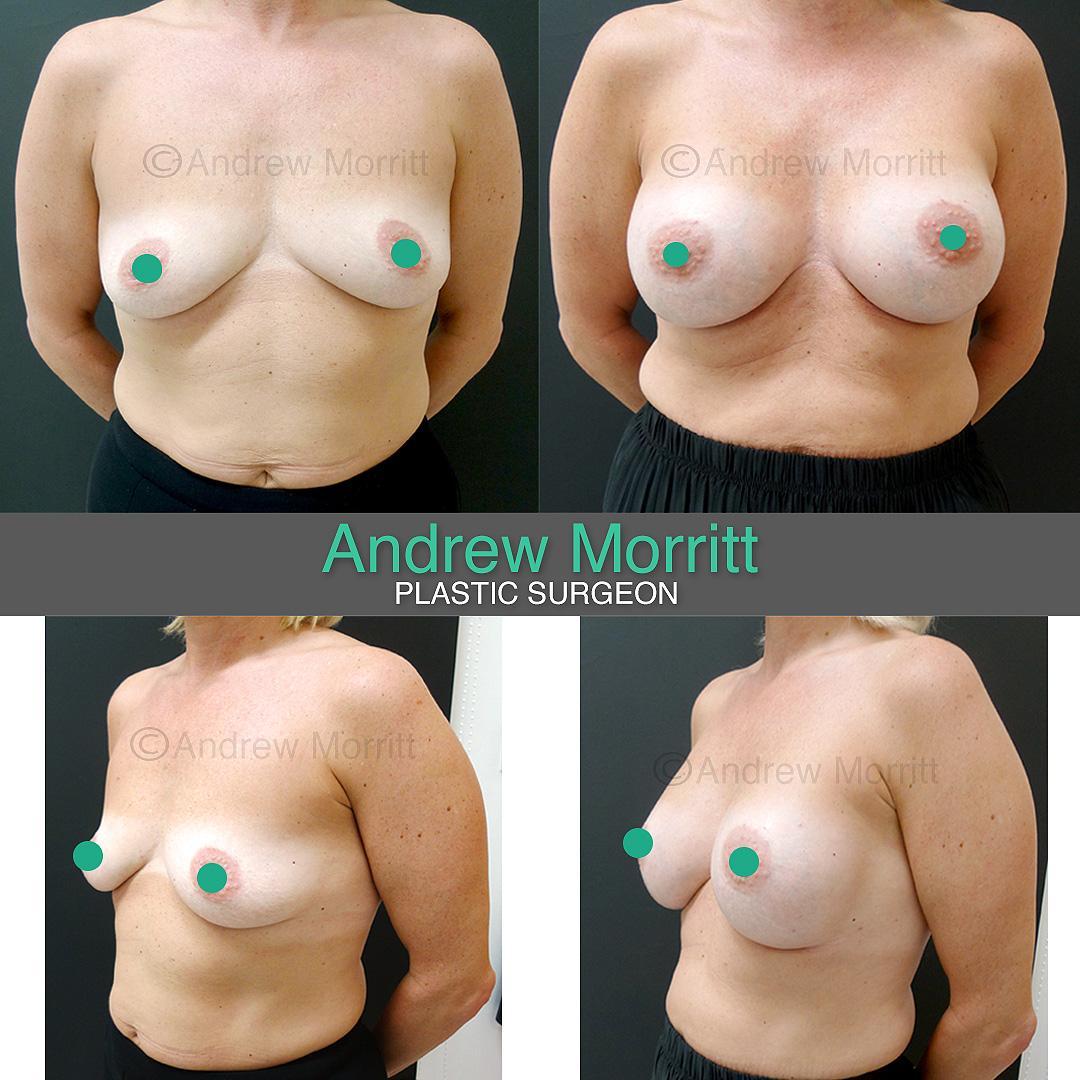
Case 14. Photos showing appearances before and after breast augmentation. Round 325cc high profile implants have been inserted partially under the patient’s chest muscle (Dual plane type 1) to restore breast volume lost after having 3 children. Thanks to my patient for giving permission to show these images.
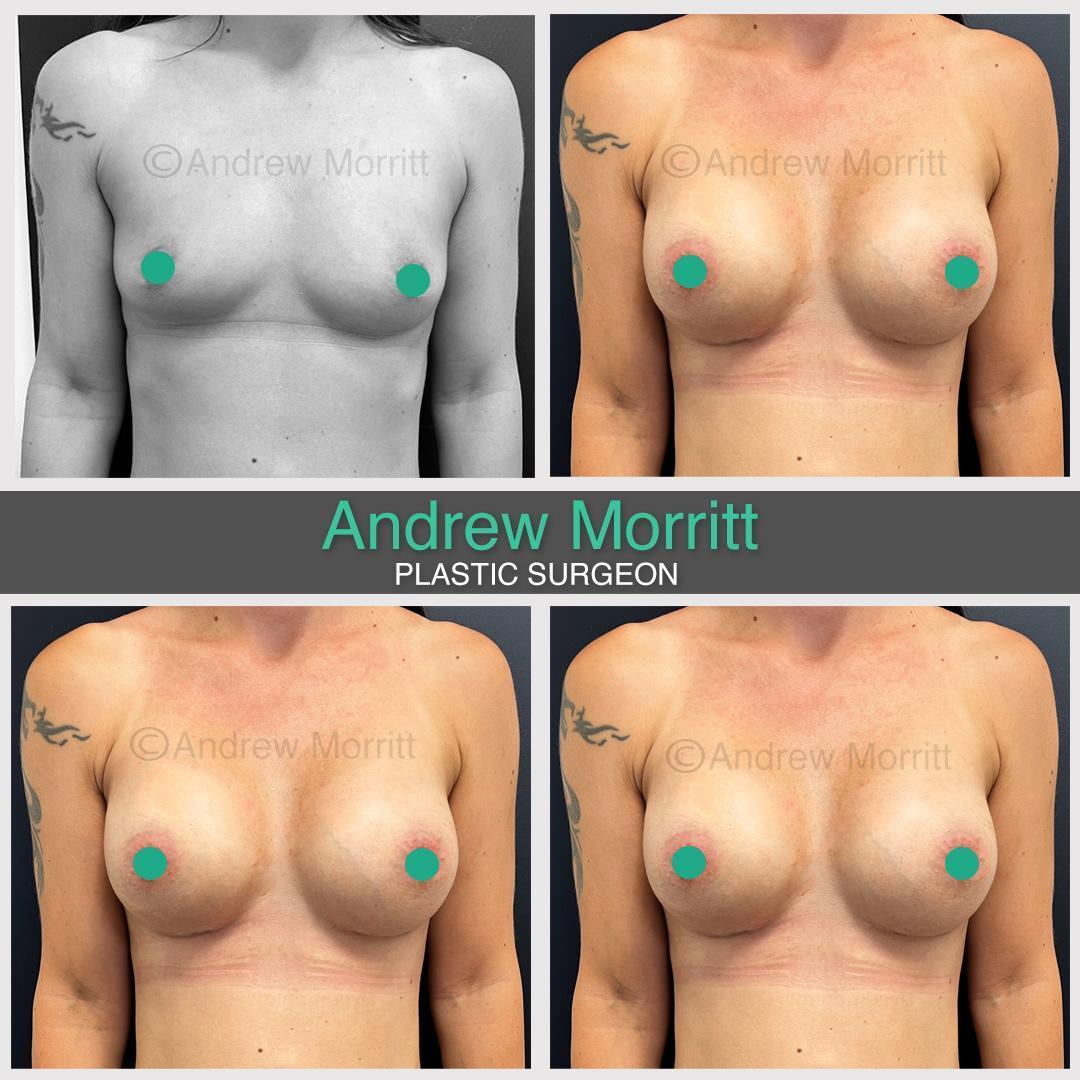
Case 15. Photos showing appearances before and after breast augmentation. Round 375cc high profile implants have been inserted on top of the patient’s chest muscle (Dual plane type 1) taking her from a 32A to 32DD Thanks to my patient for giving permission to show these images.
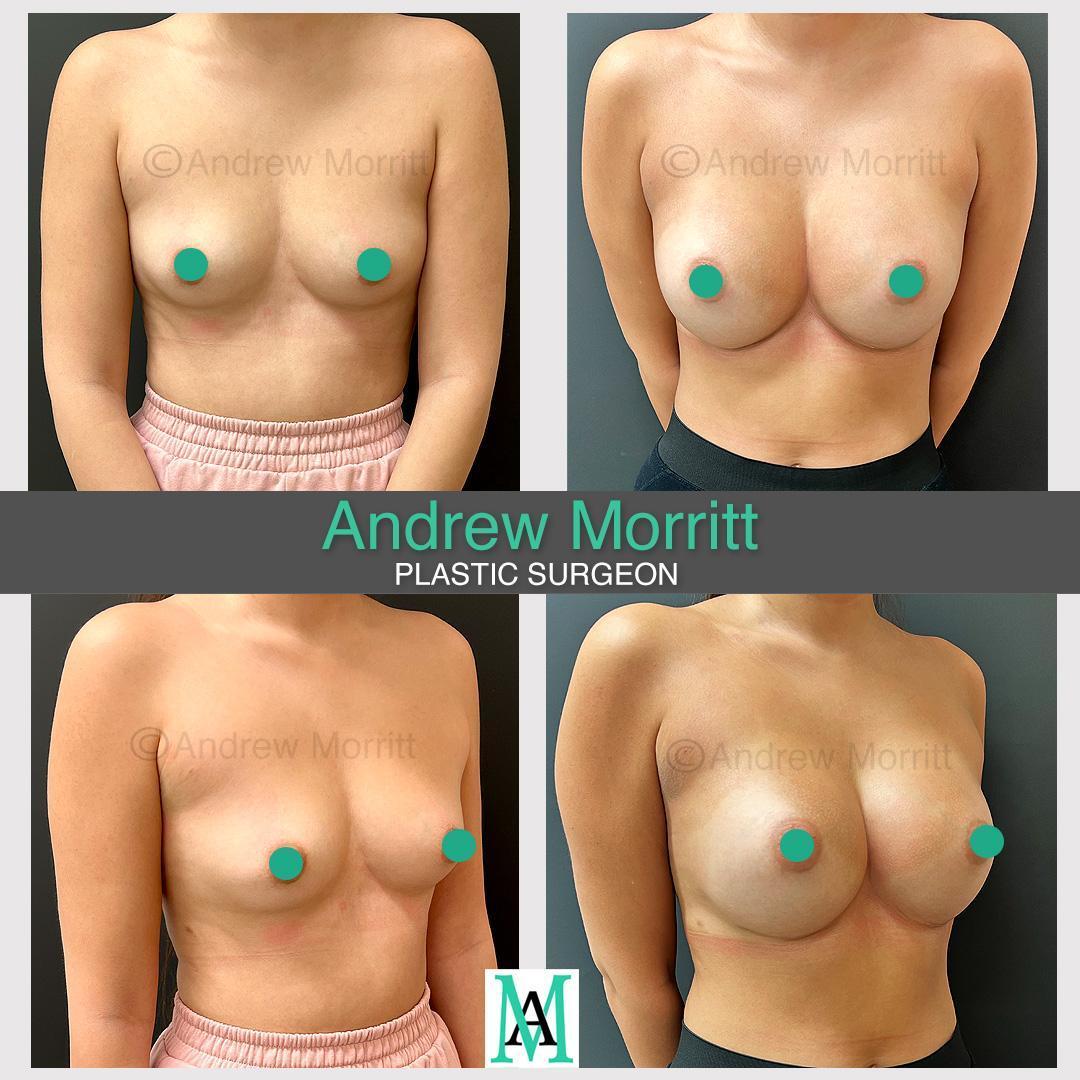

Case 16. Photos showing appearances before and 10 months after breast augmentation surgery. Round 325cc high profile silicone breast implants have been inserted under the muscle (dual plane type 1) to restore breast volume for this mum in her 30s whilst also keeping the appearances natural. Thanks to my patient for giving permission to show these images.

Case 17. Photos showing appearances before and 6 months after breast augmentation surgery. This lady in her 50s wanted to increase her breast volume and correct her breast droop. She did not wish to have the scars associated with breast uplift surgery. Round 325cc High profile silicone breast implants have been inserted partially under the chest muscle (dual place type 3). Thanks to my kind patient for giving permission to show these images.
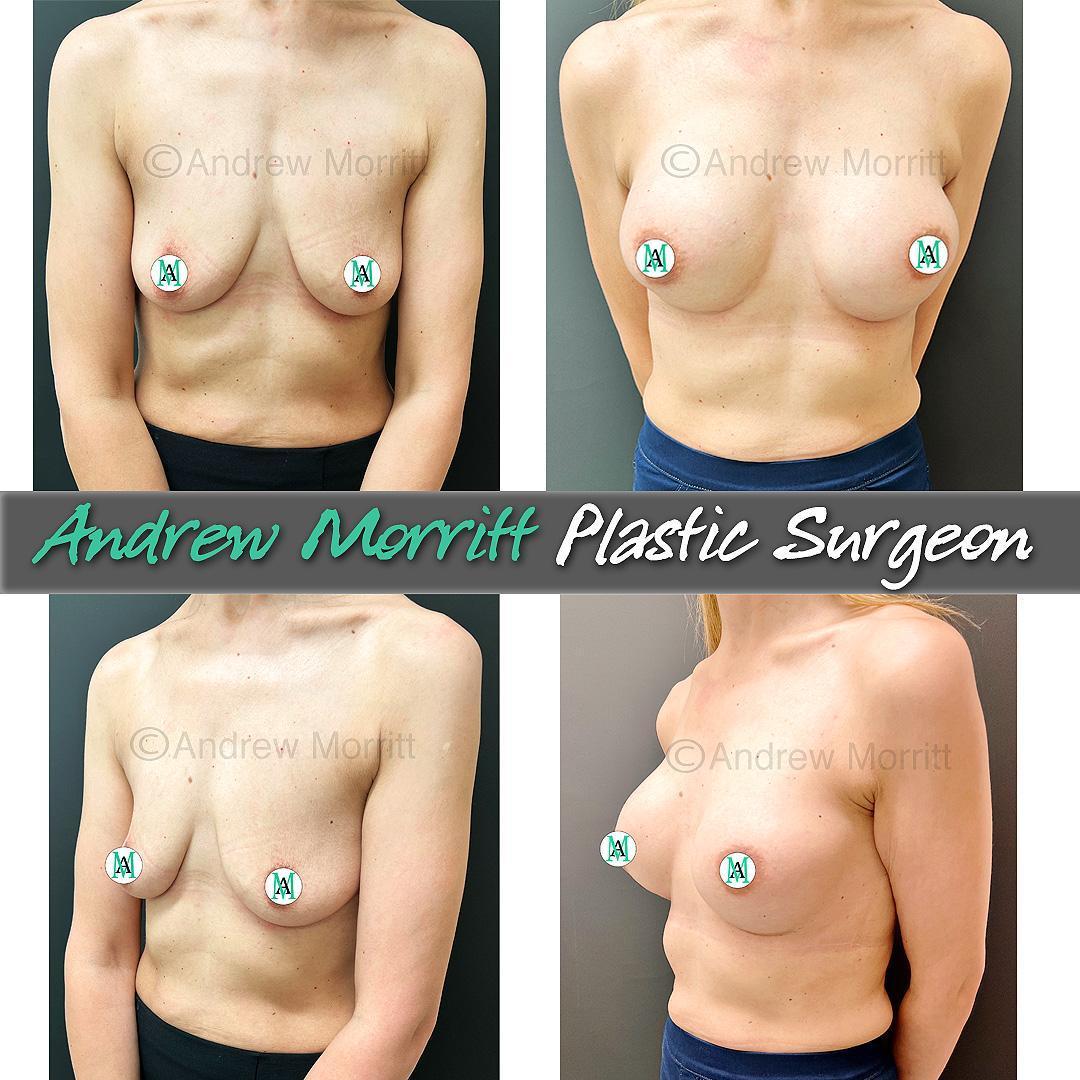
Case 18. Photos showing appearances before and after breast augmentation surgery with round silicone breast implants. This mum wanted to restore breast volume after having children. The breasts had some natural drooping and she did not want the scars associated with breast uplift surgery. A high profile round 425cc breast implant was inserted partially under the chest muscle (Dual plane type 2) to restore volume. Thanks to my kind patient for giving permission to show these images.

Breast augmentation – procedure
‘Boob jobs’ are performed under general anaesthesia and involve an overnight stay in hospital. The breast implants are placed directly under the breast (subglandular; also known as ‘overs’) or under the chest muscle (submuscular; also known as ‘unders’). Day case surgery (go home the same day as surgery) is available for suitable patients.
read moreThe incision (scar)
Mr Morritt inserts breast implants through a short scar in the breast crease (inframammary) incision. Scars in this area tend to heal very well and this incision allows an excellent view inside the breast during surgery so that a good breast shape can be created. Bigger implants or teardrop implants tend to require slightly wider scars.
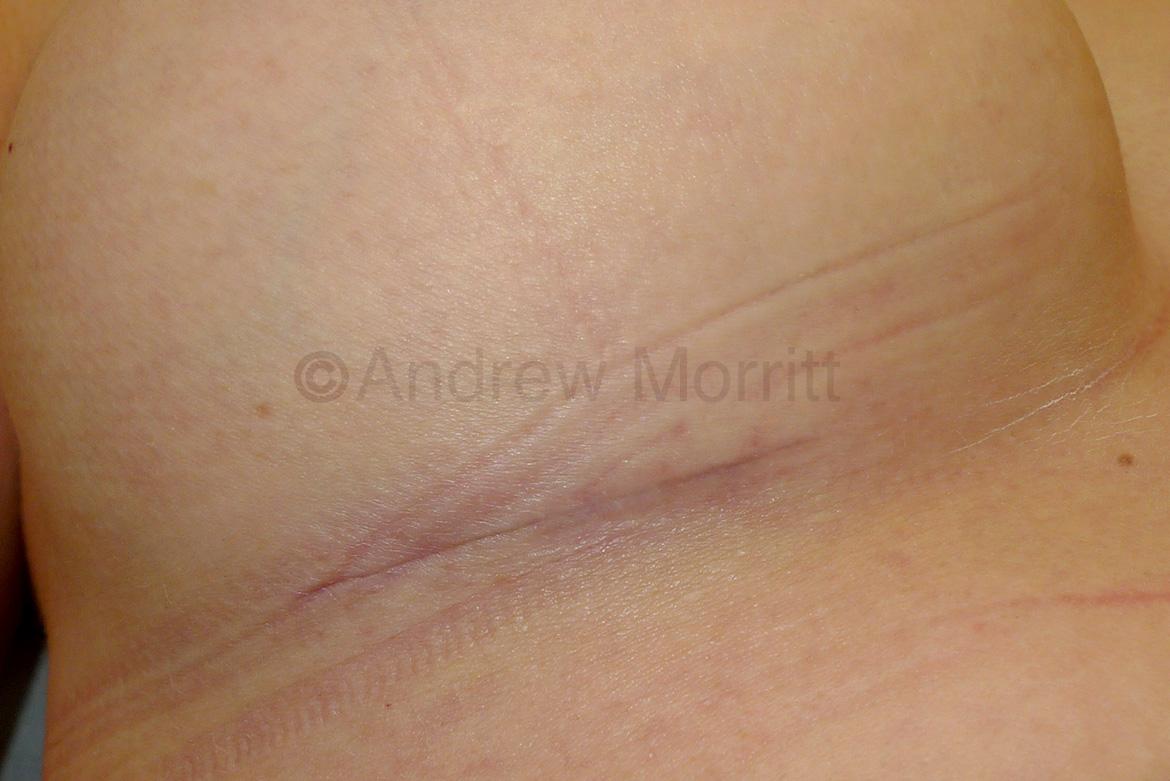
Picture shows scar appearance 6 weeks after breast augmentation surgery
Under v over the muscle
Over the muscle (Subglandular or prepectoral)
- Preferred option for patients who already have moderate/large breasts
- Less painful and less risk of bleeding following surgery compared with submuscular
- The breasts move more naturally than when implants are placed under the muscle
- The cleavage gap is often narrower than when implants are placed under the muscle
- Can fill loose breast skin better than when implants are placed under muscle
- Quicker recovery than when implants are placed under chest muscle
- Higher chance of seeing rippling or edge of implants in thin patients
Under the muscle (Submuscular or ‘Dual plane’)
- Preferred in thin patients with small breasts eg. those who have visible ribs
- Greater cover over the implant particularly in the cleavage
- Reduces chance of seeing the implant edge or feeling the implant
- Lower capsule contracture rate compared with subglandular
- More uncomfortable than subglandular in healing phase following surgery
- Slightly greater risk of bleeding following surgery
- The breasts can change shape when the chest muscle contracts (animation)
- The breasts move less naturally than with subglandular augmentation
Drains following breast augmentation surgery
Mr Morritt does not routinely use drains for breast augmentation surgery. On the rare occasions that a drain is inserted during surgery this is removed before the patient goes home.
Breast implants
Mr Morritt uses Mentor ® silicone breast implants for breast augmentation. These are high quality breast implants with good long term safety records and come with a 10 year replacement warranty in the event of rupture. Mr Morritt has never inserted PIP breast implants but regularly removes them.
To learn more about Mentor ® breast implants – click here
read moreModern breast implants comprise a silicone shell filled with either silicone jelly or saline (salt water). In contrast to old breast implants which were filled with runny silicone that could leak if the implant shell broke, modern breast implants are filled with thick silicone called cohesive gel which is similar in consistency to a jelly baby and does not leak to the same degree in the event of implant shell rupture.
Breast implants are either round or shaped (teardrop) and are manufactured in a wide range of sizes which means that different looks can be achieved in different patients and Mr Morritt will discuss the available options with you during your consultation. The most commonly requested breast implant sizes are in the range 250-450cc. Silicone gel filled implants tend to feel more natural and are more durable than implants filled with saline so are used more frequently for breast enlargement.
Round v Teardrop (anatomical) breast implants
Mr Morritt regularly inserts both round and teardrop breast implants. In patients with adequate soft tissue cover (this means patients who are starting with some breast tissue and soft body fat) the ultimate shape of the breast is very similar with both round and teardrop implants as long as implants are not excessively large. In contrast, patients who are starting with no breast tissue or minimal body fat will have less padding over the implant so the shape of the implant will be more obvious after surgery.
Round breast implants
- The most popular option for breast augmentation
- Give more fullness in the upper part of the breast than teardrop implants
- Feel softer than teardrop implants
- If the implant rotates, there is no visible change in the breast shape
- Takes on a teardrop shape when the patient is standing and gives a more natural breast shape than teardrop implants when the patient is lying down
Teardrop (anatomical) breast implants
- Gives the most natural look – namely fullness in the lower part of the breast but a flatter profile in the upper breast
- Feel firmer than round implants
- If they rotate can result in a change in breast shape which would require further surgery to correct (some reports say the incidence of breast implant rotation is 1 in 20 but my personal observations from removing breast implants make me feel that the incidence of teardrop breast implant rotation is more frequent than this)
- Surgery with teardrop breast implants is more expensive than with round breast implants as the implants are more expensive, the procedure takes slightly longer and there are slightly greater risks involved (rotation)
Fat transfer (lipofilling) breast enlargement
Breast size can be increased in some individuals with fat transfer (lipofilling). This involves using liposuction to harvest fat from the abdomen, thighs or flanks. The harvested fat is then prepared and injected into the patient’s breasts to increase their size. Only limited amounts of fat can be injected into the breast during a single operation meaning that this is not a useful technique for patients who wish to increase their breast size significantly in a single operation. Fat transfer can however be repeated a number of times if patients desire. Mr Morritt has found this to be a particularly useful technique in patients with breast asymmetry where the smaller breast can be increased in size without the need for an implant. Other good candidates for fat transfer breast enlargement surgery are those who have lost a small amount of breast volume after weight loss or childbirth and want to restore this volume without implants.
Hybrid breast augmentation – breast implants & fat transfer
Mr Morritt also sometimes combines breast implants with fat transfer. Examples of this combined approach are where patients want to narrow the gap between breasts (more cleavage), to improve the thickness of soft tissue cover over the implants, or to reduce/avoid double bubble deformities that can happen in some patients where the distance from the nipple to the breast skin fold is short.
Breast augmentation with nipple lift of breast uplift
Mr Morritt frequently performs this surgery. To read more about breast augmentation with uplift: click here.
Breast augmentation – after surgery
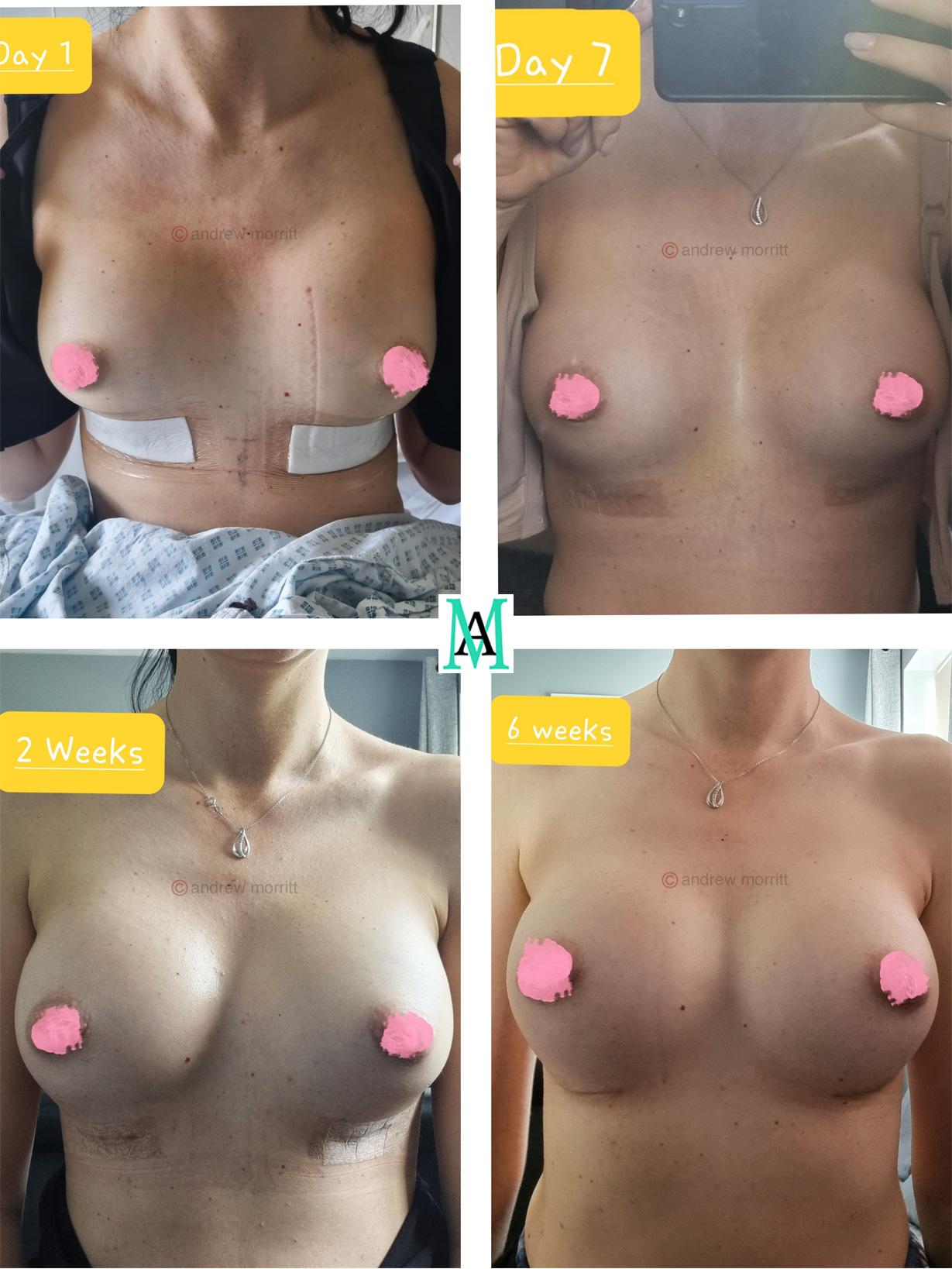
Photos showing the ‘drop and fluff’ process after breast augmentation surgery. With time the skin stretches and swelling goes down resulting in a better breast shape (for some patients this can take 6 months).
Patients usually stay in hospital for one night then go home the day after surgery. Patients are reviewed by the nursing staff 1 week after surgery and the dressings are changed to micropore tape. Patients are then seen at 6 weeks and sometimes at 6 months after surgery by Mr Morritt. If patients have any concerns or encounter any problems they are seen more frequently.
read moreBra
Patients are required to wear a post surgical bra or sports bra 24/7 for 6 weeks following the surgery except when showering. We supply one bra but most patients find it useful to have two bras that can be worn in rotation. It is important that the bra is comfortable and provides support without being overly tight. Patients should not wear an underwired bra for approximately 6-8 weeks following surgery as the skin under the breast can be numb for some weeks following surgery and can be damaged by pressure from the wiring.
Dressings
The wounds will be covered with dressings. Mr Morritt uses internal, self dissolving stitches so there is no need for any stitches to be removed. The dressings are showerproof so you can have short showers following surgery. Please be aware that the wounds are relatively fragile in the first week following surgery and care must be taken when washing/drying the breasts. Patients are advised to avoid submerging their breasts in a bath until at least 4 weeks after surgery.
Breast augmentation – recovery timeline
Most patient’s wounds are healed within 2 weeks of breast augmentation surgery but internal breast healing takes a few more months. Patients are therefore advised to avoid strenuous exercise for at least 6 weeks following surgery.
read more0-7 days following surgery
Mr Morritt recommends taking it very easy in the first week during surgery as this is the most frequent time to encounter problems such as bleeding or fluid accumulation (seroma) following surgery if patients overdo things. Patients with young children should therefore organize for help and support with childcare and housework during this period. It is normal for the breasts to seem slightly high and also firm at this stage.
7 days following surgery
Patient’s are reviewed by the nursing staff to check that healing is satisfactory.
7-14 days following surgery
Patient’s should only have low levels of pain at this stage following breast enlargement and will be able to gradually increase their activities e.g. walking as their energy levels allow.
3-6 weeks following surgery
Most patient’s should be able to return to work approximately 1-2 weeks following surgery. Mr Morritt advises that patient’s should not undertake any heavy lifting or strenuous exercise before 6 weeks following surgery. Those in active jobs may therefore need to take more time off work or to modify their activities at work until they have fully healed.
6 weeks
Patients are reviewed by Mr Morritt in clinic. Assuming that healing has adequately progressed, scar management is commenced. Patient’s can get measured from new bra’s but are advised to be careful if wearing underwired bras as these can damage the skin if sensation to the skin has not fully returned.
6 weeks onwards
Patients can undertake all exercises without restriction. The breasts should have softened and look more natural but will continue improve over the next 5 – 6 months. For those who have their breast implants inserted under the chest muscles Mr Morritt advises waiting until 3 months after surgery before undertaking strenuous chest muscle exercises such as bench pressing, press ups, pole dancing etc.
Breast augmentation – risks
Breast augmentation is a commonly performed procedure and for the vast majority of patients the surgery goes very well without problems. Mr Morritt has incorporated a number of safety modifications into his practice to reduce the risks for patients having breast enlargement surgery. As with all surgical operations there are potential risks that patients should be aware of before proceeding with breast enlargement.
read moreScar
- scars following breast augmentation tend to heal well but will vary between patients and some patients (6.3%) may get poor scars (also called hypertrophic scars – red, thick, raised, painful)
- the scars fade with time and can take up to 18 months to fully settle
- The scars are never invisible but sometimes are difficult to see
- The scars tend to be located in the crease under the breast but for some patients the scars will be located on the skin of the breast or tummy
- Larger implants and teardrop implants require slightly wider scars for insertion
Significant bleeding
- results in a collection of blood in the breast that will make the breast appear swollen and may cause pain
- This blood has to be removed in the operating theatre
- Rare – affects approximately 2-3% of patients
- More frequent when implants are placed under the chest muscle
- Patients are advised to avoid strenuous activity and lifting for 6 weeks following surgery to minimise the risk of this complication. Patients are also advised not to take NSAID’s (ibuprofen, aspirin etc) 2 weeks before or after surgery as these are associated with an increased risk of bleeding
Infection
- Infections are rare following this surgery (0.5%)
- Shallow infections (of the skin) can be treated with a course of antibiotics but deeper infections (of the implant itself) are more difficult to treat and sometimes it is necessary to remove the implant. If the implant is removed for infection then it is normal practice to wait 2-3 months for the infection to settle before inserting more implants
Asymmetry of breasts or nipples
- almost all women have different sized/shaped breasts
- Breast augmentation can sometimes make differences between breasts and nipples more noticeable or less noticeable
- There will always be differences in breast size, shape and nipple position following breast enlargement surgery
Wound breakdown after breast augmentation
- this is very rare but requires removal of the breast implant if the implant gets exposed to the air
Significant capsule formation (capsular contracture)
- this causes the breast to harden, change shape (become rounder) and can become painful
- usually further surgery is necessary to correct this problem (capsulectomy)
- CPG implants 3.6% at 10yr; Round memory gel implants 5.2% at 10yr (Baker 3 or 4)
Visible/palpable implant/Rippling following breast enlargement
- This is more common in thin patients or patients with only a small amount of breast tissue
- Breast implants naturally ripple and this rippling can sometimes be seen as rippling of the breast skin
Permanence of result
- Breast appearance changes with normal ageing, pregnancy, breast feeding and weight change.
- The appearances created with breast enlargement surgery do not last forever
Need for more surgery in the future
- All patients having breast enlargement surgery are warned that they will need to have surgery on their breasts again at some point in the future and should budget for this
- This may be to replace implants that have ruptured or for capsular contracture
- Some patients develop breast drooping and decide to have breast uplift surgery
- Other patients decide to increase or decrease the size of their implants
- Some patients decide to have their breast implants removed.
Long term effect of breast implants on surrounding tissues
- breast implants can cause permanent thinning of the breast skin and of the breast tissue
- breast implants can cause permanent indentation of the rib cage
- breast implants increase the weight of the breast and this can cause breast drooping with time
- silicone can leak from the implants into surrounding tissues or lymph nodes and this can be permanent
Lifespan of breast implants
- breast implants last different amounts of time in different people but at some stage will rupture
- breast implants last on average between 10 and 20 years
- Ruptured implants need to be removed or replaced which requires further surgery
- It is not always possible to remove all the silicone from the body (breast/chest tissue/lymph nodes) in the event that a breast implant ruptures. Sometimes the silicone cannot be seen with the naked eye during surgery to remove the implant and may only become apparent when a lady goes for a mammogram/scan
Breast implant rupture
- Breast implants can rupture
- This is unusual within the first 10 years after surgery but becomes more likely as time goes on
- Trauma etc can cause rupture of breast implants
- CPG 6.6% at 10yr; Memory gel round implants 9.8% at 10yr
Breast implant gel bleed
- The silicone inside a breast implant can over time gradually leak through the shell of the implant even when the implant shell is intact
- Is less common with the current generation of breast implants than it was with older breast implants
Nipple and skin sensitivity alterations after breast enlargement
- reduced nipple sensitivity occurs frequently following surgery and is more frequent when larger implants are inserted
- may affect one or both sides
- generally improves with time
- Numbness may be permanent in 10% of patients
- Rarely, the nipples may become hypersensitive
- Very rarely, patients may get chronic pain after breast enlargement surgery
Breast animation for subpectoral breast implants (under the muscle)
- When breast implants are placed under the chest muscle it is normal for the breast to change shape to some degree when the muscle contracts
- Rarely this phenomenon can happen spontaneously when the patient is not actively tensing the chest muscle
BIA – ALCL (Breast implant associated – anaplastic large cell lymphoma)
- a very rare type of cancer which has been identified in some patients who have had breast implants
- Worldwide, approximately 1200 cases have been reported (includes 20 disease-related deaths)
- The lifetime risk for BIA-ALCL ranges from 1:88,300 for those with textured implants (Mentor implants). To put this in perspective the lifetime risk of getting breast cancer for a women is 1:8. Smooth implants have a 0% BIA-ALCL case.
- Typically presents 8-10yrs after breast augmentation with a visible, painless swelling of the breast due to seroma (fluid accumulation). Less frequently patients notice a lump in the breast (this is in the capsule surrounding the breast implant).
Squamous cell carcinoma (SCC) associated with breast implants
- recent reports have identified squamous cell carcinoma (cancer) in the capsule around breast implants. This is likely to be exceptionally rare and to date has been identified in 20 patients worldwide.
Breast implant sickness or illness (BII)
- Some patients with silicone breast implants can develop fatigue and general ache/pains
- In these patients usually no cause can be found to explain their symptoms after extensive investigations
- Removing the implants can sometimes improve the symptoms
- Extensive scientific studies have failed to prove the existence of this condition and it is not currently recognised as a disease by the World Health Organisation
- Many doctors think that these patients are actually suffering from fibromyalgia and it is simply a coincidence that the patients have breast implants
Breastfeeding after a ‘boob job’
- approximately 80% of women can still breastfeed after breast augmentation
Unhappiness with size or shape of breasts after breast augmentation
- Mr Morritt cannot promise that inserting breast implants will create a specific breast shape as the effects of breast implants vary between individual patients. In fact, two friends with identical size breast implants may get very different breast sizes and shape after a ‘boob job’
- Mr Morritt cannot give an exact indication of expected bra size following breast augmentation as bra sizes vary between different manufacturers. An approximate prediction is given about expected cup size.
- Breast implant size changes after surgery are sometimes possible but these incur an additional charge payable by the patient.
Rotation
- 1.3% with Mentor CPG teardrop implants at 10yr.
Malposition
- less than 1% at 10years with textured implants.
Stretch marks
- the breast skin can develop stretch marks after breast augmentation surgery. This is more common when people with small, tight breasts have larger than average sized breast implants
Breast implant scares
- Patients having breast implants are made aware that medical knowledge improves with time. In the future some breast implants will almost certainly be found to have an increased complication rate etc and may be recalled or removed from the market
Association of breast implants with autoimmune and connective tissue diseases
-
- early scientific reports in 1980’s suggested a link between silicone implants and connective tissue diseases e.g. scleroderma, rheumatoid arthritis, SLE etc
- all studies have concluded that there is no association between silicone breast implants and any connective tissue disease
Seroma
- tissue fluid accumulation immediately after surgery can happen and if significant may require drainage with a needle.
- It usually settles within a few weeks of surgery.
- Rarely, patients may suffer from long term fluid accumulation (chronic seroma) around breast implants and in this situation the implants usually need to be removed (0-1% of patients).
‘Double bubble’
- a bulge in the bottom of the breast
- this can happen after time if the implant slips below the natural breast crease. It is more common with smooth implants and/or larger implants
- sometimes it is necessary to lower the natural breast crease during surgery to accommodate implants. This is frequently done when the distance from the nipple to the breast crease is shorter than average e.g. tuberous breasts or tight lower pole. Usually the crease will stretch to some degree and appearances will improve but for some patients this does not occur resulting in a ‘double bubble’ appearance.
- Correction may require revision surgery such as exchange of breast implants to smaller implants, fat injections (lipofilling) or skin tightening (uplift surgery).
A ‘non-perfect’ result
- All surgery carries the risk that the outcome will not be ‘perfect’. Sometimes ‘non-perfect’ outcomes can be improved with revision surgery. In other cases if the risks involved with revision surgery outweigh the potential improvement or if revision surgery is unlikely to meet the patient’s expectations, a recommendation is made to accept a ‘non-perfect’ outcome and not undertake revision.
General risks of breast enlargement surgery
- chest infection, DVT, PE, Death, COVID-19
Frequently asked questions – Breast augmentation (Boob job)
Mr Morritt answers FAQs on the Claremont Private Hospital, Sheffield website – click here to read more.
Are silicone implants safe?
Silicone implants have been used for breast augmentation for more than 50 years. During this time large independent studies have established the overall safety of silicone breast implants. Concerns regarding an increased risk of autoimmune disease in patients with silicone breast implants have not been proven in these studies. I personally think that some patients do suffer from ‘breast implant sickness’ but again this condition has not been proven to exist in research studies. In recent years, it has become clear that there is a risk of a rare cancer with breast implants called BIA-ALCL (breast implant associated – large cell lymphoma). With Mentor implants the risk of developing BIA-ALCL is thought to be 1:24000. It should be noted that ALCL also occurs after things like hip replacements and pacemaker insertion so is not a condition exclusively related to breast implants. To date, we have had 3 patients in Sheffield with BIA-ALCL.
I really like the breasts in this photo – can you make mine like that?
read moreIt is really helpful for patients to bring photos to the consultation that they like of other patients surgical outcomes from breast augmentation surgery as this helps in the discussion about the likely outcome of surgery. Mr Morritt also has an image bank of previous patients who have had breast enlargement surgery which can be viewed in the consultation so that patients can see achievable outcomes from the surgery. Mr Morritt is unable to promise any patient that their breasts will end up looking exactly like those in a photograph. This is for a number of reasons including the fact that breast implants have different effects for different patients – in fact if two consecutive patients had the same size and shape breast implant inserted the outcome can still differ. Similarly, photos of breasts can differ when in clothing or with non standardised lighting/positions. A range of expected outcomes is therefore given.
Will I experience any pain after the procedure?
read morePatients differ in how much pain they experience following breast augmentation surgery. Some patients may be free of pain within 3-4 days following surgery whereas others may have discomfort for 2-3 weeks. Most patients find that the pain following breast augmentation surgery can usually be well controlled with tablet medication. Severe pain following breast augmentation is less common. Younger patients sometimes experience more pain following surgery than older patients and submuscular breast implant placement can also be more painful than when the breast implant is placed over the muscle (subglandular).
How long will I need off work? What is the recovery time?
read morePeople heal at different rates following breast enlargement. Furthermore, physical activity requirements do vary between different jobs. While some patients may feel ready to return to work one week following breast augmentation surgery, others may not feel ready to return until two weeks after the surgery. Those with particularly strenuous jobs will need to take a bit longer off work or to restrict their duties to light activities during the first six weeks following surgery. Usually all patients are fully healed and are able to return to normal activities including exercising at six weeks following surgery. We advise that patients avoid driving until they are completely pain free and can perform an emergency stop confidently so that they are covered by their insurance policies.
Can I come back and see you anytime if I’m worried about anything?
read moreYes. We aim to provide excellent aftercare following breast enlargement surgery. You will be given a follow-up appointment before you leave the hospital following the surgery (this is usually 7 days following surgery). You will then have a number of further follow-up appointments to check that you are progressing well following the breast augmentation surgery. There is an opportunity to answer any questions and address any concerns that you may have at these appointments. Patients are usually seen 6 weeks and 6 months following breast enlargement surgery but are seen more frequently if necessary. You will also be provided with contact details so that you can contact the team at any time following the breast enlargement surgery for advice or review if you have any concerns.
When can I drive after breast augmentation surgery?
read moreI generally recommend that patients do not drive in the first week after breast augmentation surgery. As a general rule, it is not advisable to drive until patients are no longer having pain or discomfort and have also stopped taking pain relief medications.
When can I go on holiday after breast augmentation surgery?
read more I recommend that patients allow at least 6 weeks to heal before going on holiday after breast augmentation surgery. Patients are also advised to take care in the sun after breast enlargement surgery for a number of reasons. Firstly, if the scars are exposed to strong sunlight early on in recovery then they can become permanently tanned. Secondly, the breast skin can still be numb in places after surgery and in combination with altered breast projection it is not uncommon for patients to get sunburn if they are not careful. When do the stitches come out after breast augmentation surgery? read more After inserting breast implants, I close the wound with internal stitches that self dissolve within two to three months after surgery. There are therefore no external stitches to remove after surgery. It costs £205 for the initial breast augmentation consultation with Mr Morritt. This fee covers all further consultations within a 1 year period from the initial breast enlargement consultation. Mr Morritt charges £100 for breast implant check ups that take place more that 1 year after surgery (for patients who have had surgery done by Mr Morritt). Guide prices (subject to change): The prices for surgery are fixed (we do not offer discounts) and include all costs related to surgery, one surgical bra, and all aftercare for 6 months to 1 year after surgery. Our prices for breast augmentation are price matched with other reputable providers locally and nationally to ensure that they remain competitive. Beware of UK companies offering low cost breast enlargement surgery – this is only possible because of compromises on the surgeon, the hospital or the breast implants. When I first started surgical training in 2000 it was common to see patients having breast augmentation or ‘boob jobs’ on the NHS for purely cosmetic reasons. Patients with common conditions such as hypomastia (small breasts) or postpartum breast changes (breast deflation after pregnancy) were entitled to have breast enlargement on the NHS. Fast forward 20 years and it is now rare for patients to have breast augmentation on the NHS. Breast enlargement for cosmetic reasons on the NHS requires funding approval (IFR) by the Clinical Commisioning Group (CCG) and the criteria are strict. This application must be made by your GP. In South Yorkshire the criteria (click here for whole policy document) for getting breast augmentation for cosmetic reasons on the NHS are as follows: Replacement of breast implants on the NHS is generally only available if the breast implants were originally inserted on the NHS. Read about Breast Augmentation (American Society of Plastic Surgeons) Read about Breast Augmentation (BAPRAS) Read about Breast Augmentation (BAAPS) Read about BIA-ALCL (Breast implant associated Anaplastic Large Cell Lymphoma) (MHRA) Read about PIP breast implant review (Department of Health, UK) Click here to read the PIP implant Catalogue Breast implant associated Anaplastic large cell lymphoma – latest summary of cases (FDA, USA)
How much does breast augmentation (a ‘boob job’) surgery cost?
read more
Breast augmentation (breast enlargement) on the NHS
read more
Breast augmentation reviews (Mr Morritt)
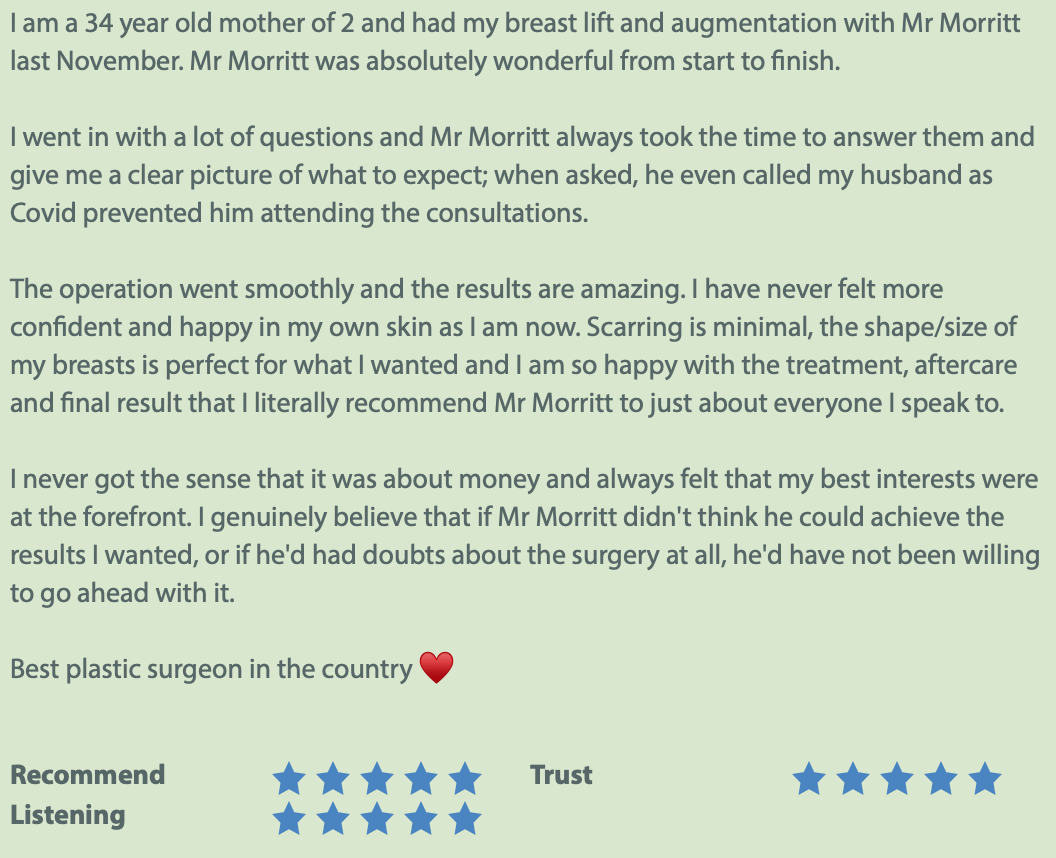

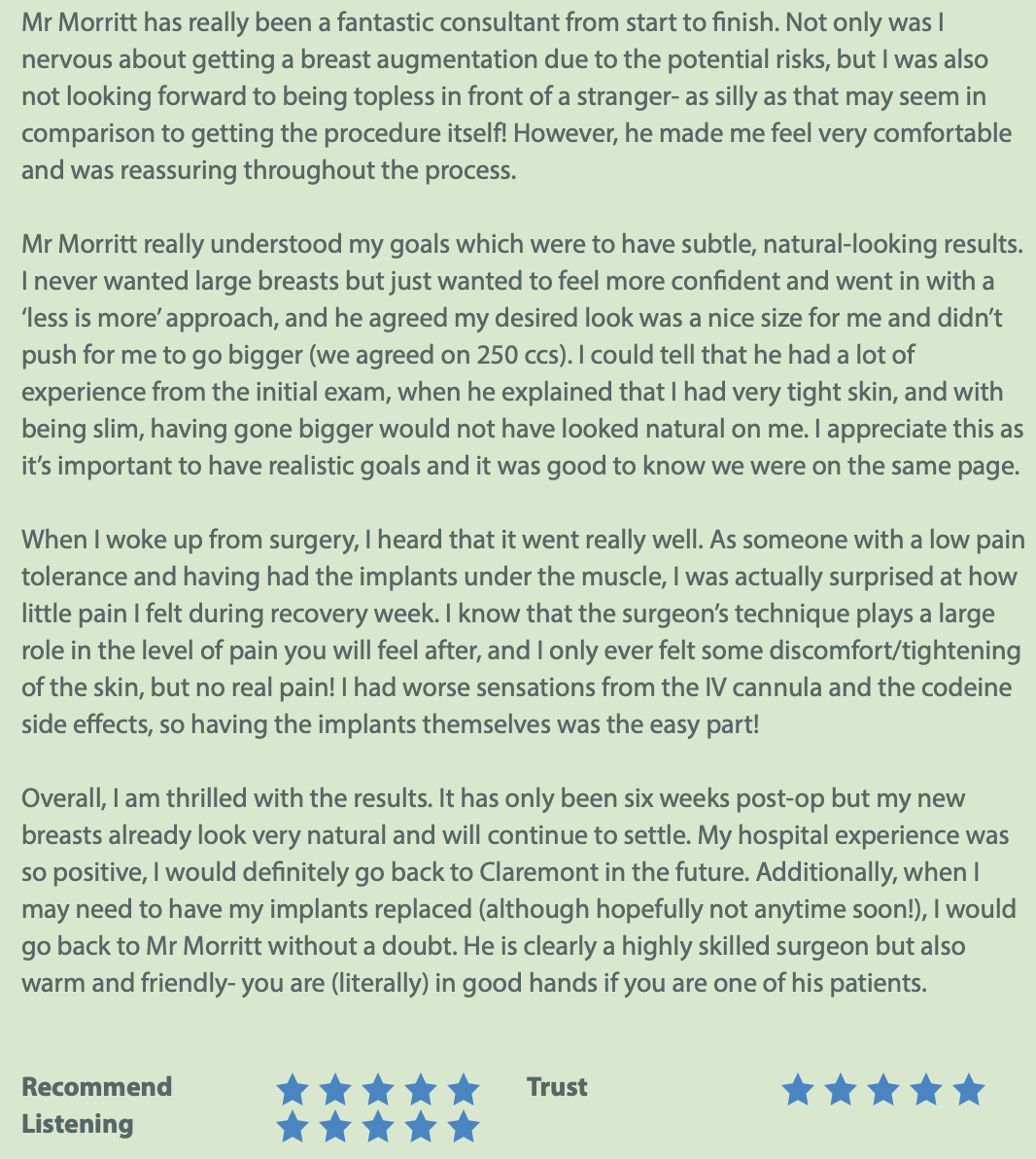
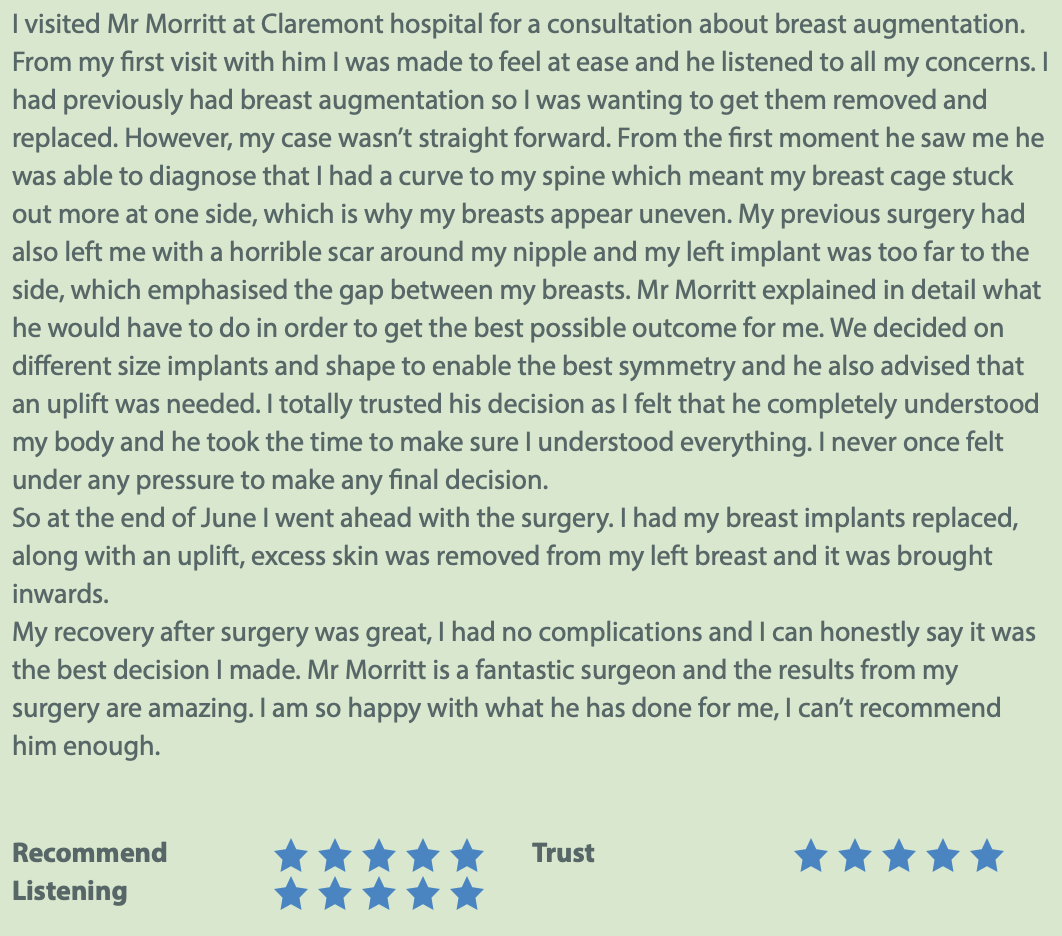
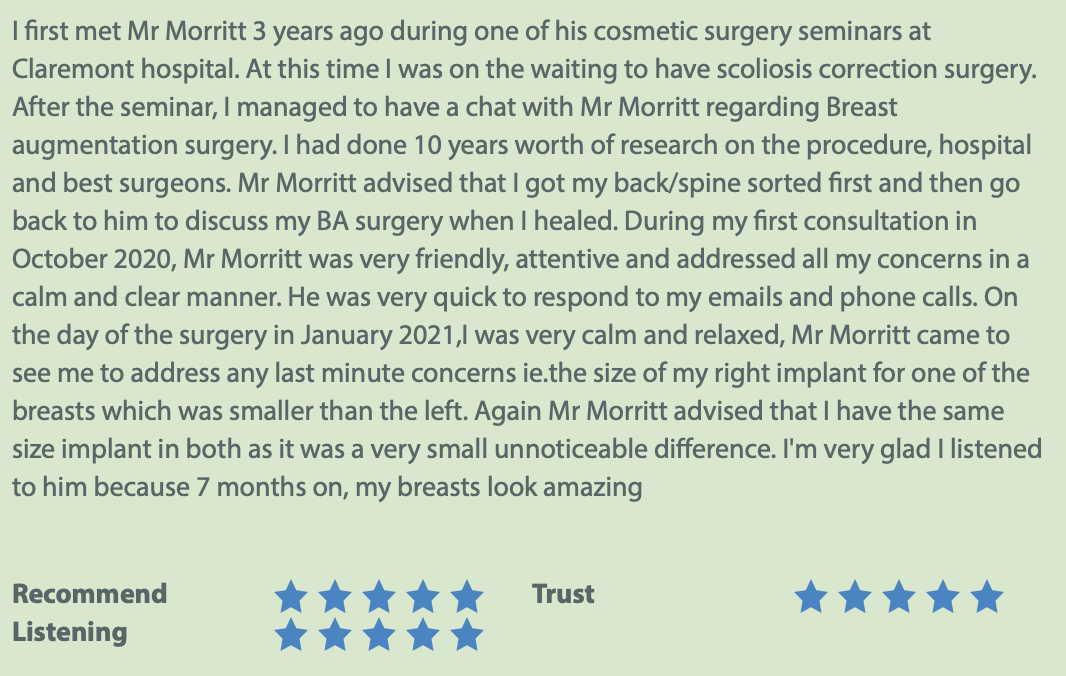
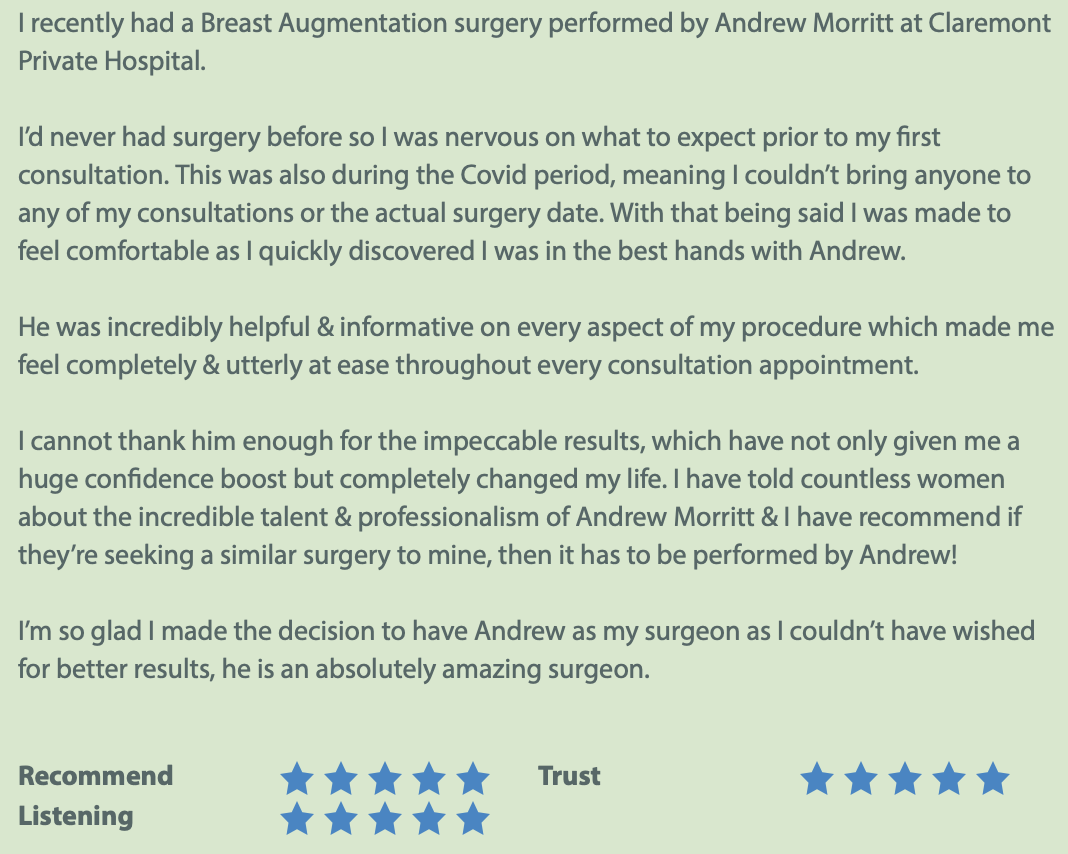
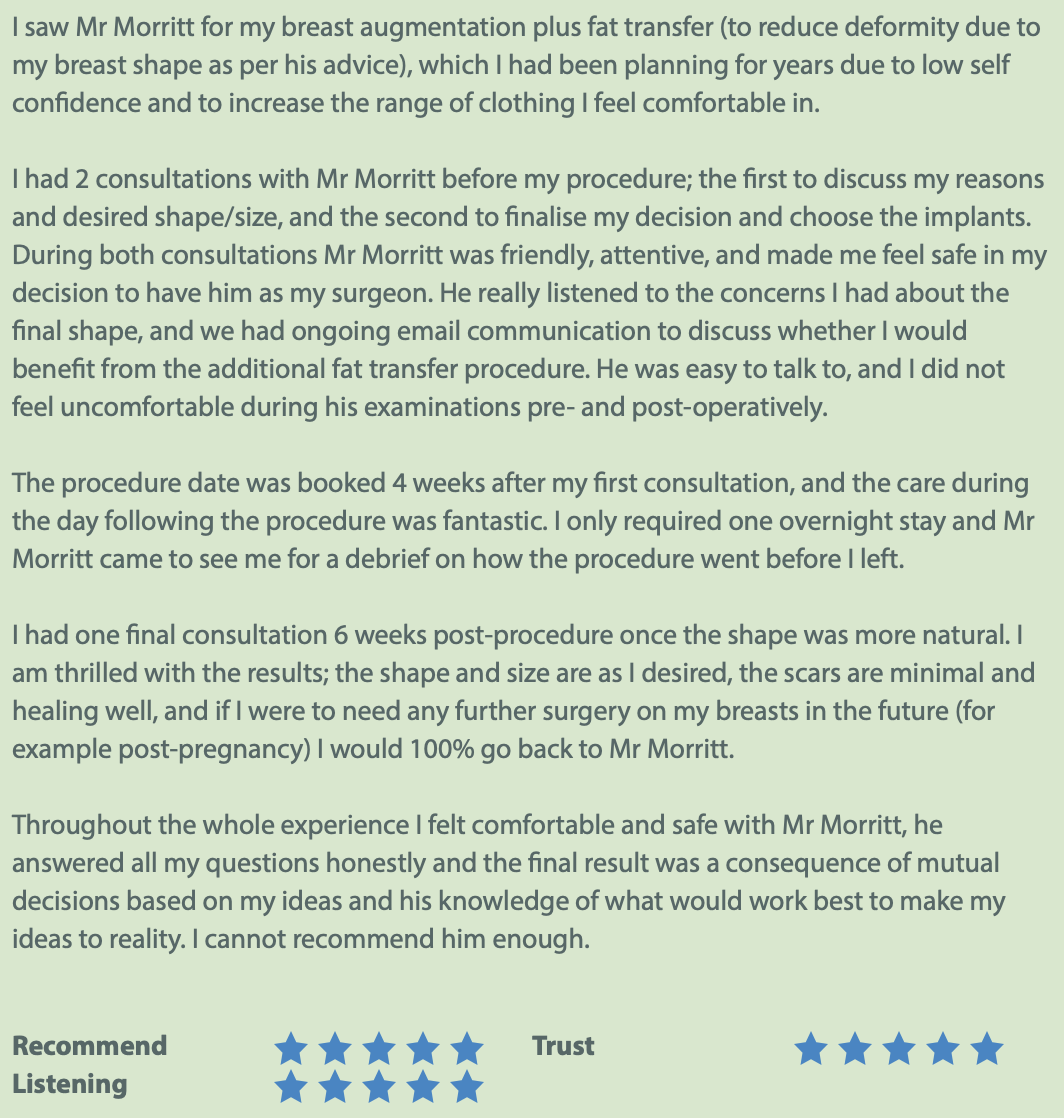
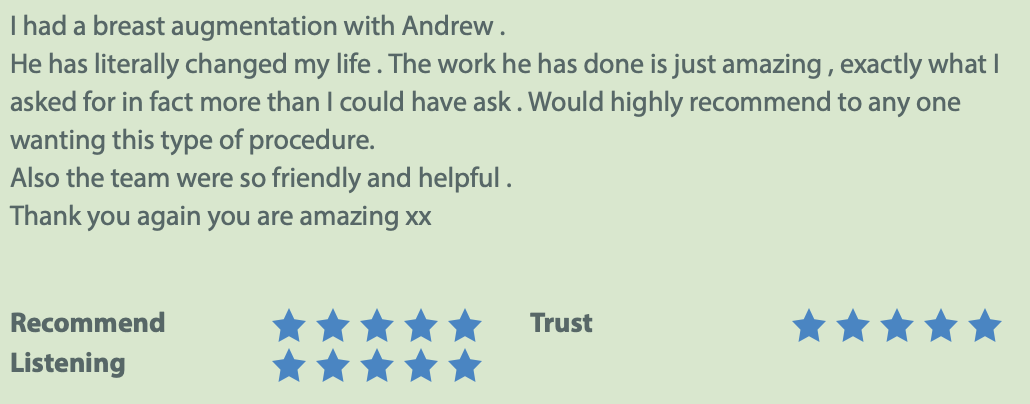
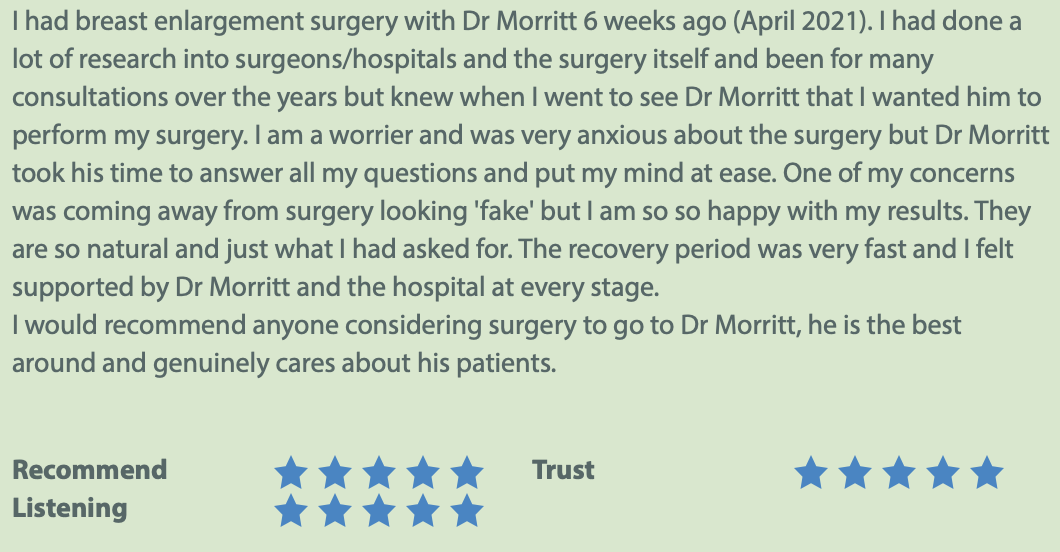
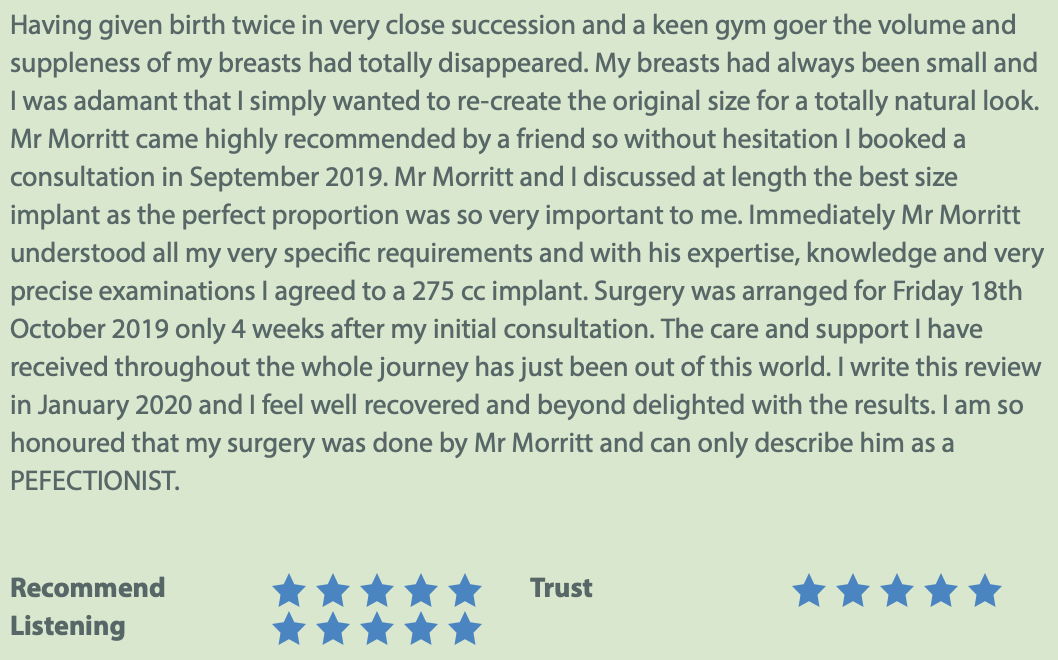
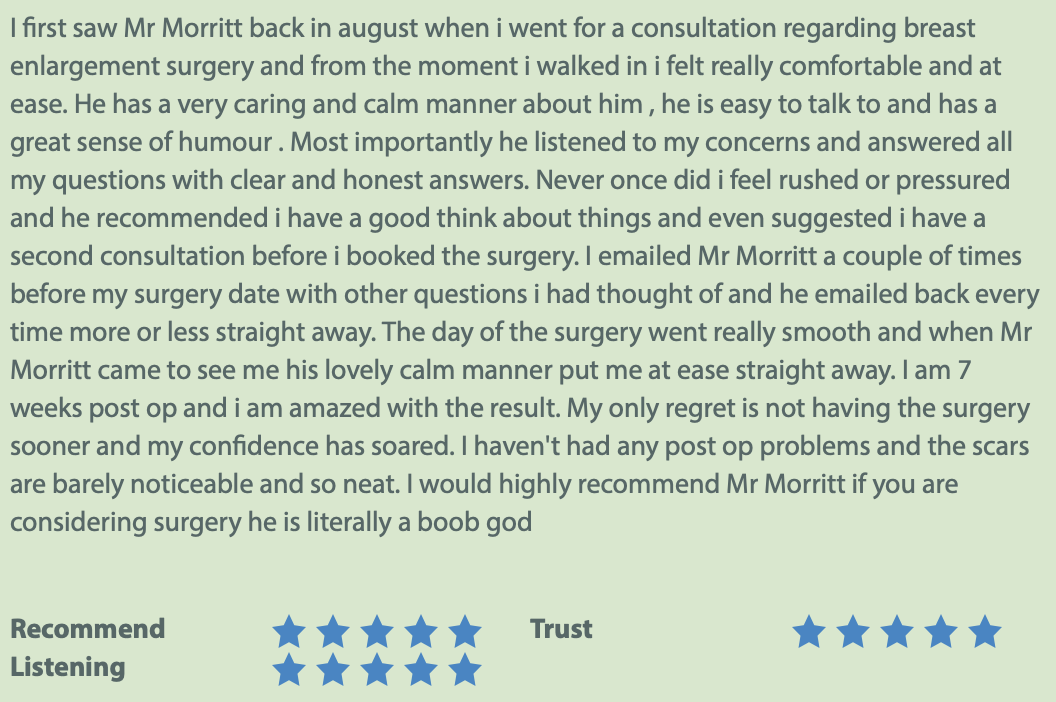

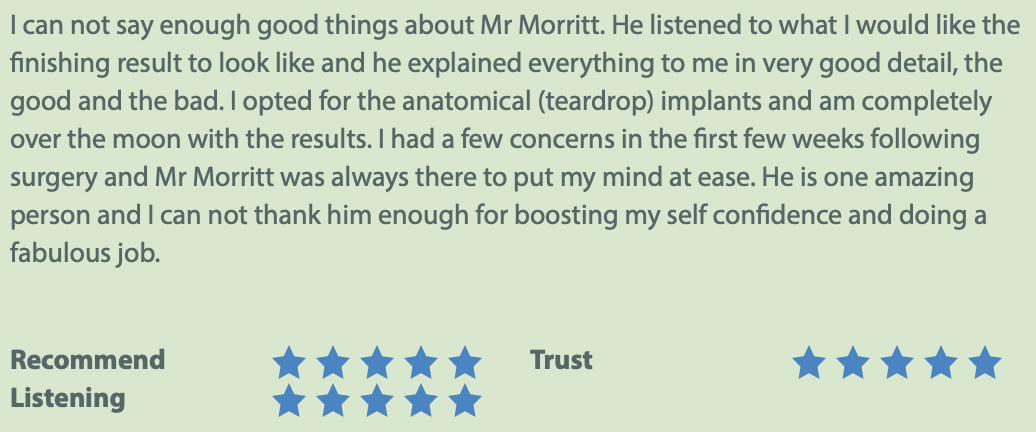
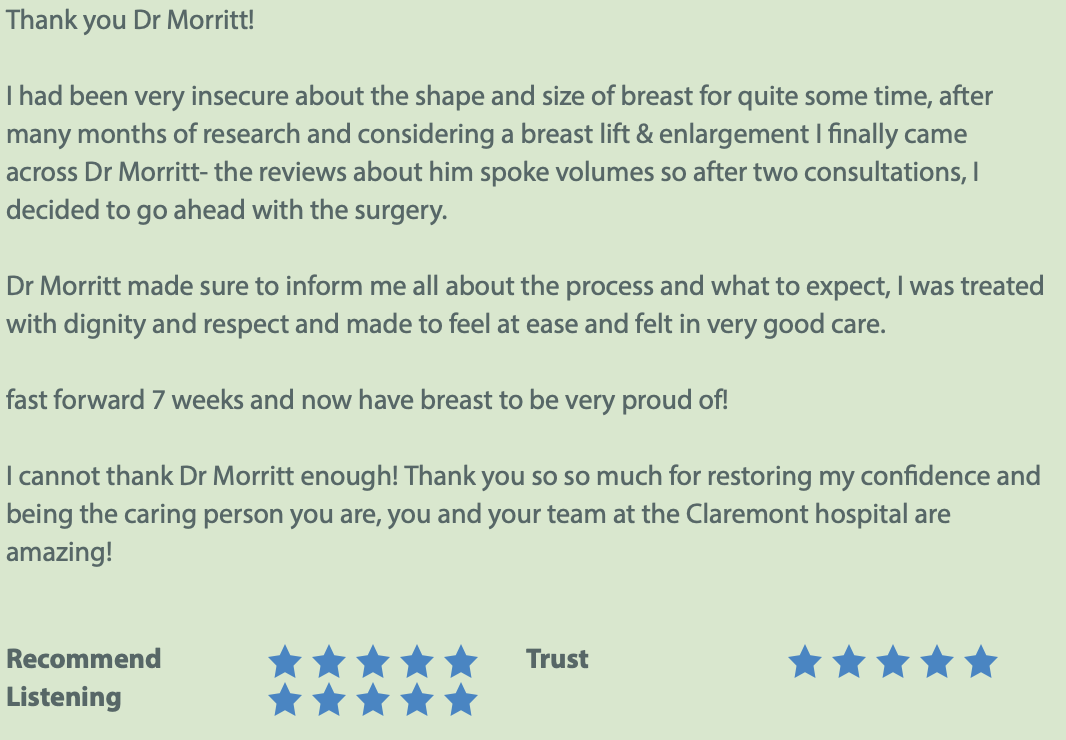
Breast augmentation (boob job or breast enlargement) links
read moreBook your breast augmentation consultation in Sheffieldw


